|
1992-1997: Cruising Speed to the New Millenium Locomotion Soundtrack - Running On Time Click here to name a vehicle! 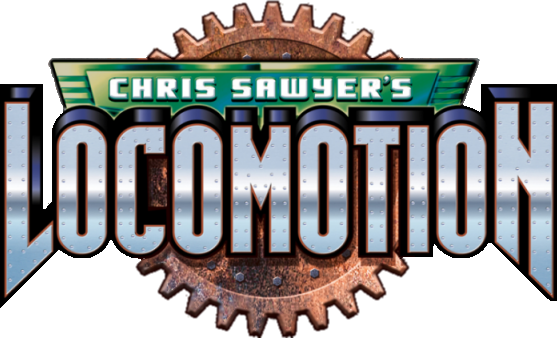 We're on the final straight now, and things are settling down. The map is so crowded now that it's almost impossible to connect the few industries remaining. I wish I have more to report. 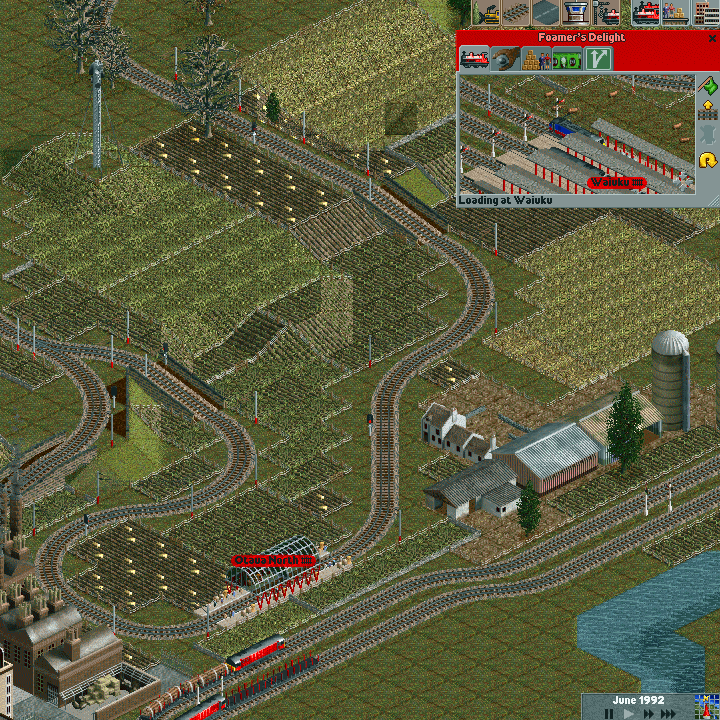 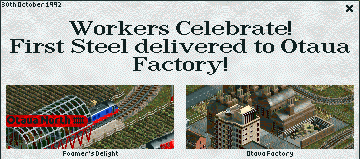 The factory in Otaua gets a supply of steel from the nearby mill. This is handy because a small train here keeps the steel rating up while the main steel delivery (to Manukau City) can get a longer train. 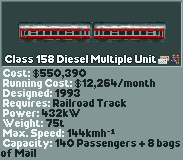  A couple of new hovercraft take up a new route from Kawakawa Bay to Waiheke Island. 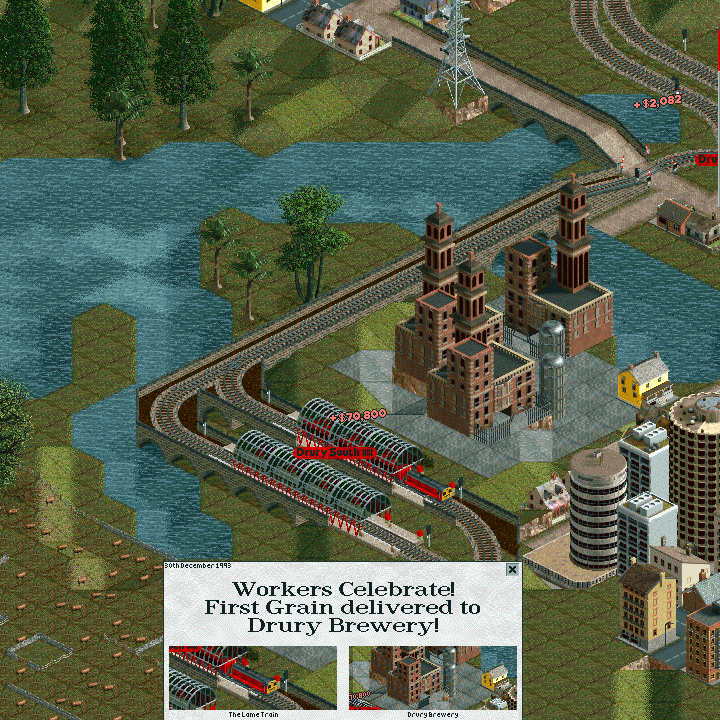 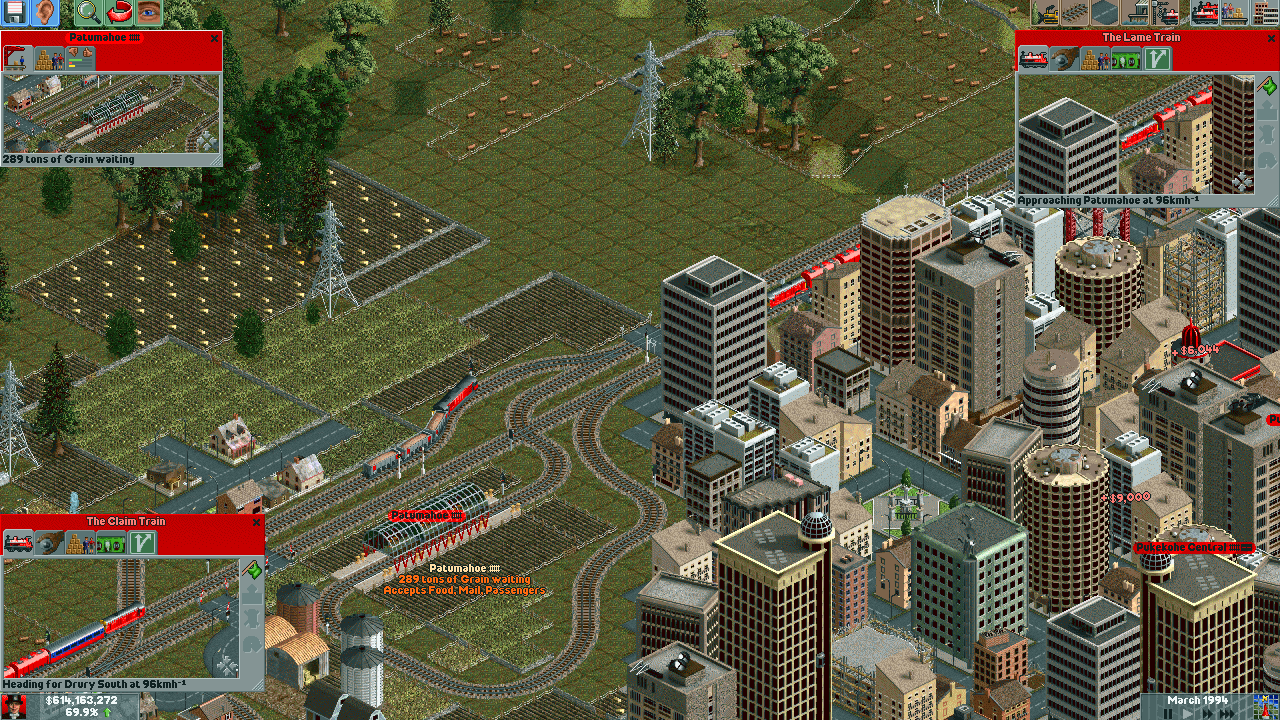 Another pair of branches picks up wheat and supplies it to the Jolly Farmer's house brew in Drury.  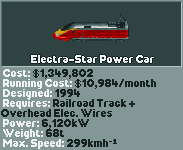 A brace of new locomotives promises increaed power and reliability. 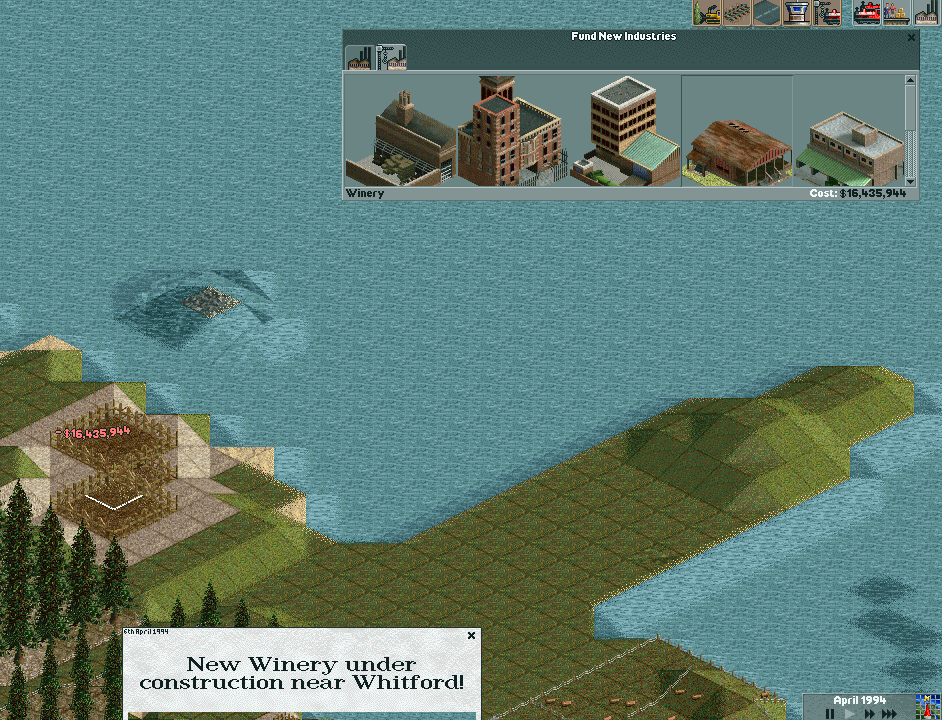 This plant won't ever make back it's costs, but have you seen how much money we've got? It doesn't even phase me. 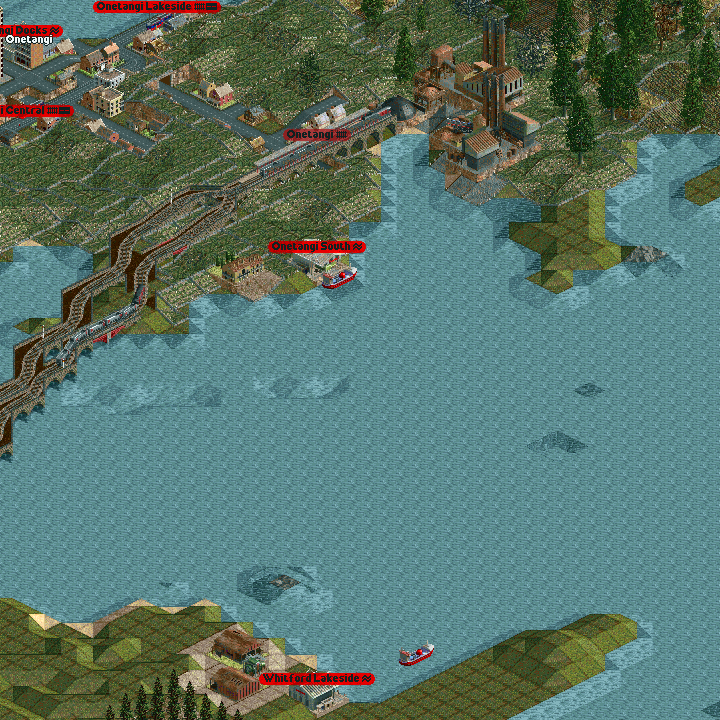 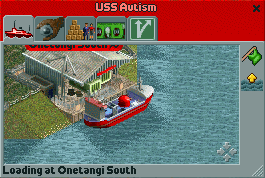 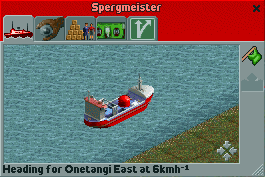 The vinyard on Waiheke isn't even big enough to support two ships really. 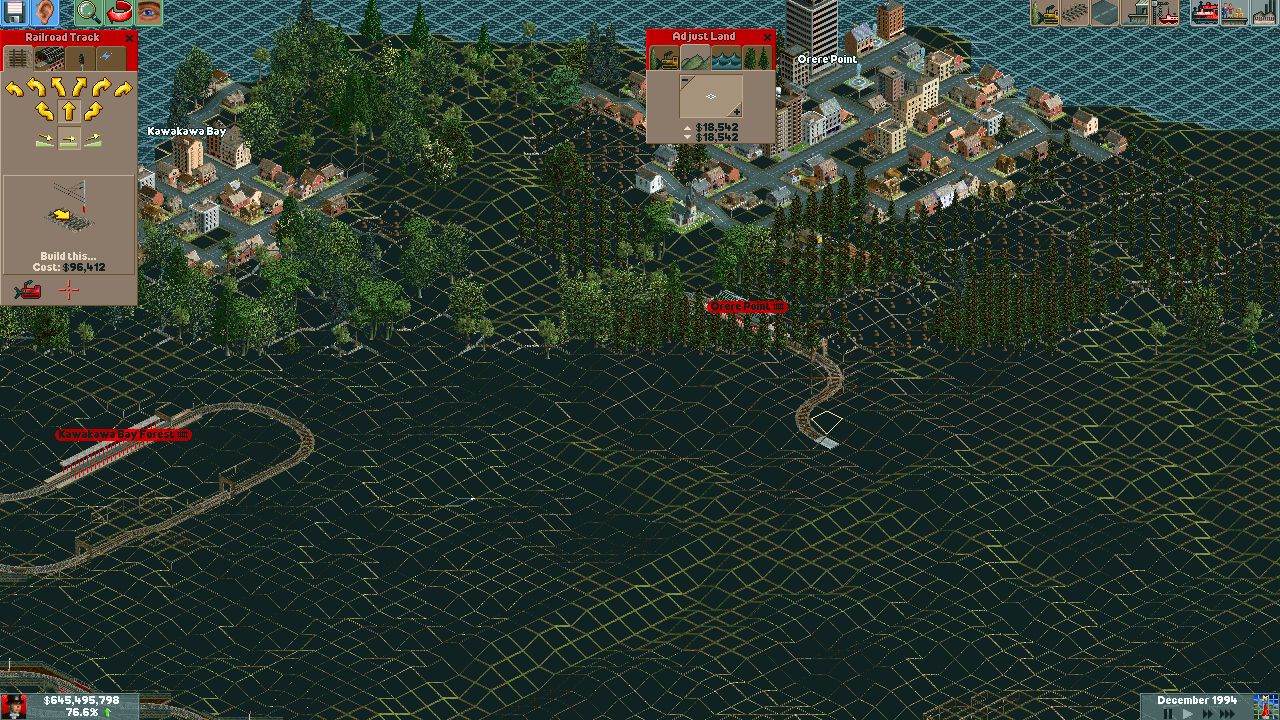 Meanwhile, an extension to the recent Kawakawa bay branch is going in. Unfortunately there's barely a square foot of flat land between the farm and the forest. 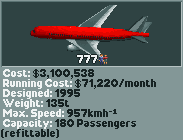 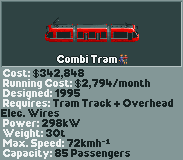  In the middle of that, one of our busiest delivery plants closes down. Replacing this is a no-brainer - but not right now! 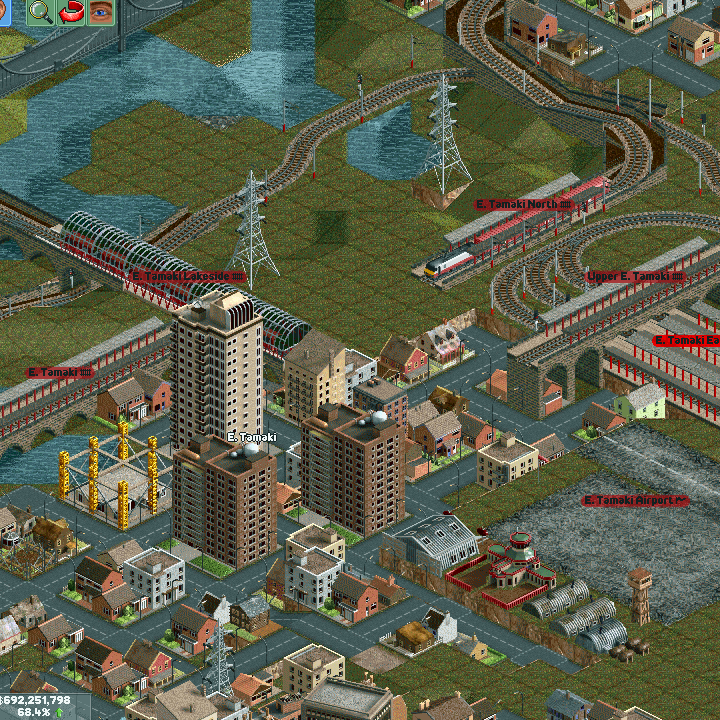 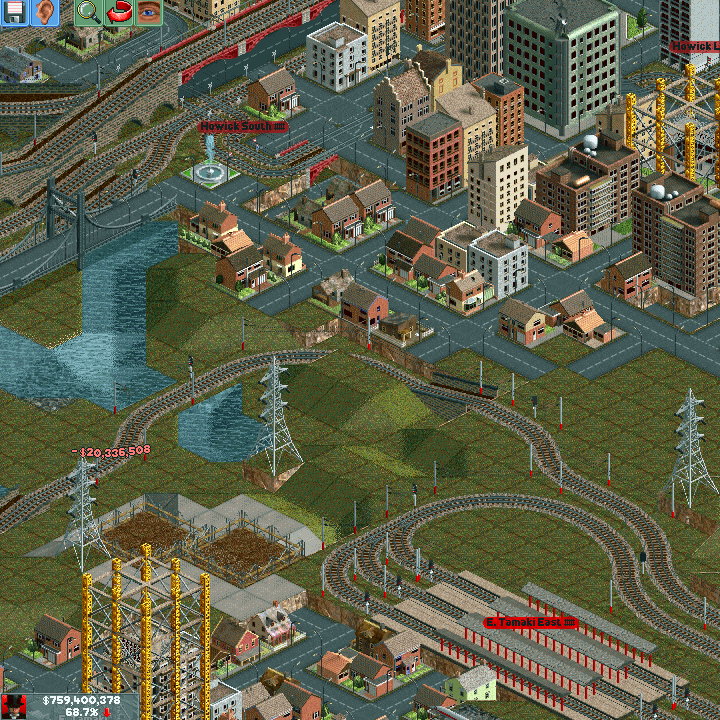 We wait a year or two for the opposition to clear off. We lose money on a dozen trains during that time, but by this stage, Scrooge is too busy receiving gold sponge-baths from hot nurses to worry the small things. 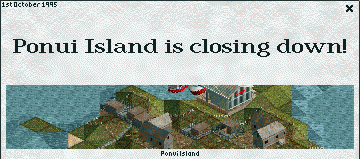 Now this is unfortunate. We can't replace it and I am forced to scrap five ships - the first vehicles in the game to be truly lost. 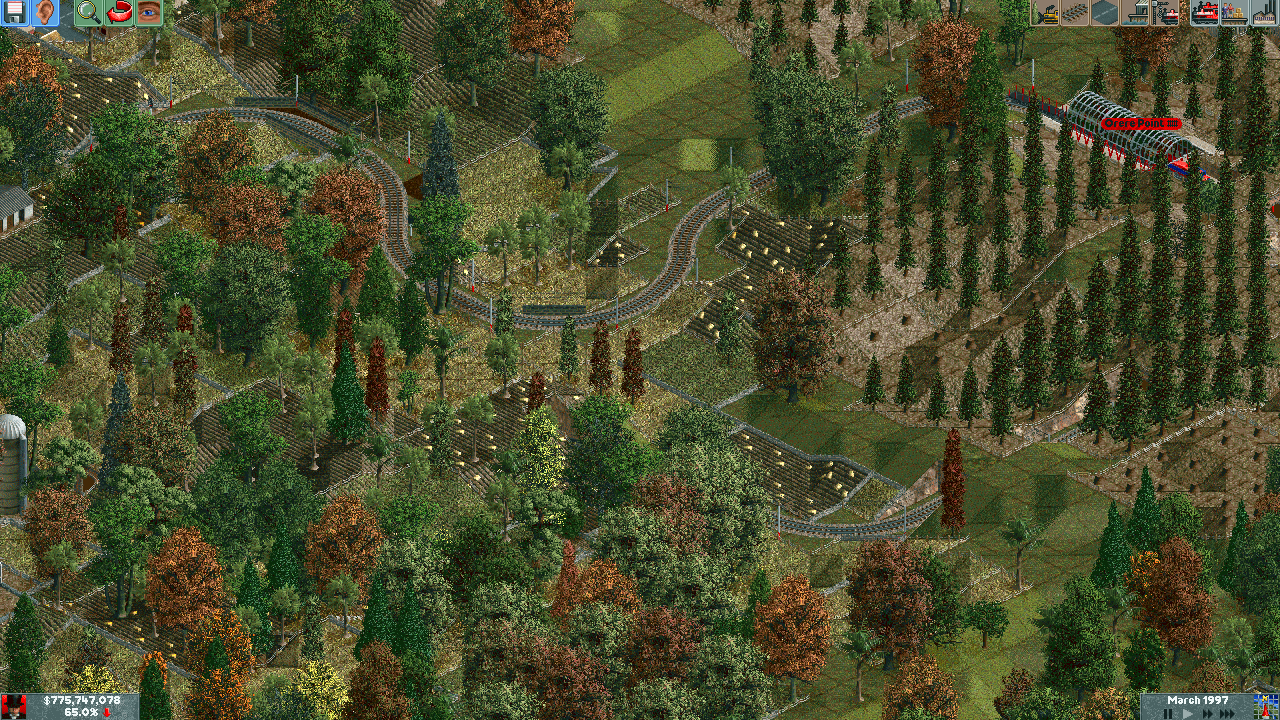   The extention is complete and we buy some of the latest and greatest to haul lumber. Oddly, the most logical place to haul to is Henderson, on the other side of Auckland city. To do otherwise would mean tearing enormous holes through a series of huge cities. 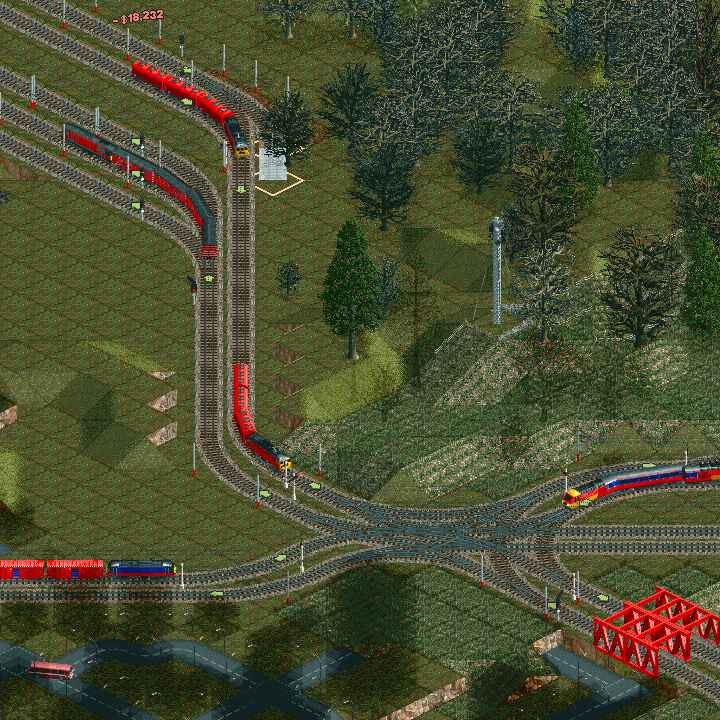 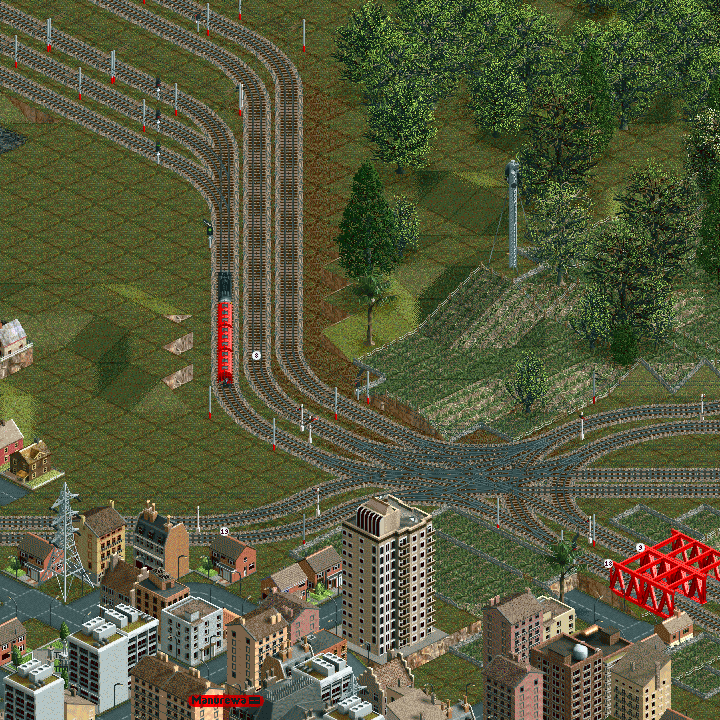 While we're fiddling around at East Tamaki, seperate the station exit and the southbound mainline to make the local junction even more complicated. Not pictured - me failing to update waypoints, scattering trains to the four corners of the map. 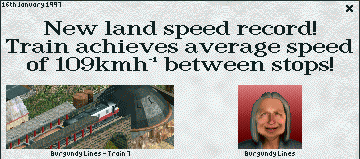 Eggburt must be trying out the new high speed train. 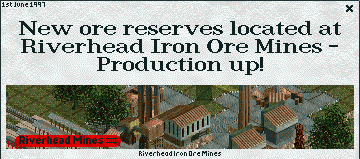 This is one of the first production increases we've seen on this map. In spite of delivering three quarters of the way across the map, the service here is very reliable. So now is the time for any final requests. In the next update I'll review the old challenges and try fulfill them all, especially the ones relating to cross-map passenger services, I'll play on a few years into the new millennium and then we shall call it a day.
|
|
|
|

|
| # ? Apr 19, 2024 17:54 |
|
Oh wow, towns can just close down entirely? I would not have expected them to go that far.
|
|
|
|
I think that was just a bug with the newspaper, or Jaguars! didn't let the page fully load before taking a screenshot. You could bulldoze a town down to the last building and it won't vanish, it'll just be a name over an empty field for a bit but eventually the buildings will be rebuilt. It looks like a livestock farm closed and we're not playing with the 'found primary industry' rule enabled, so we can only build industries that process raw materials.
|
|
|
|
I'm working on a [hopefully] three-topic bonus effortpost to release as a thank you to Jaguars! for the LP and y'all for reading my ramblings. The planes are related to some of the designs in the game in one way or another, but not included, so I hope you don't mind about that... 777's and 737's and 321's all don't really have anything effort-post-worthy about them. I'm sort of taking this post to heart: Glazius posted:I don't have any requests other than, before this is done, find something else you feel is worth talking about. I love me an effortpost.
|
|
|
|
Spaced God posted:I'm working on a [hopefully] three-topic bonus effortpost to release as a thank you to Jaguars! for the LP and y'all for reading my ramblings. The planes are related to some of the designs in the game in one way or another, but not included, so I hope you don't mind about that... 777's and 737's and 321's all don't really have anything effort-post-worthy about them.  Glazius posted:Oh wow, towns can just close down entirely? I would not have expected them to go that far. There isn't actually a town on Ponui Island, so I named the farm there after it's location. You may have noticed that here and there there are industries named after their real life counterparts, especially near the start of the game. By coincidence, I was working near where I started the Whitford Winery the other day and it was a nice day, so I took a panorama. The big headland is in the center and the hills just showing on the right are where the new plant was located. Ponui I. is visible to the right of the headland. 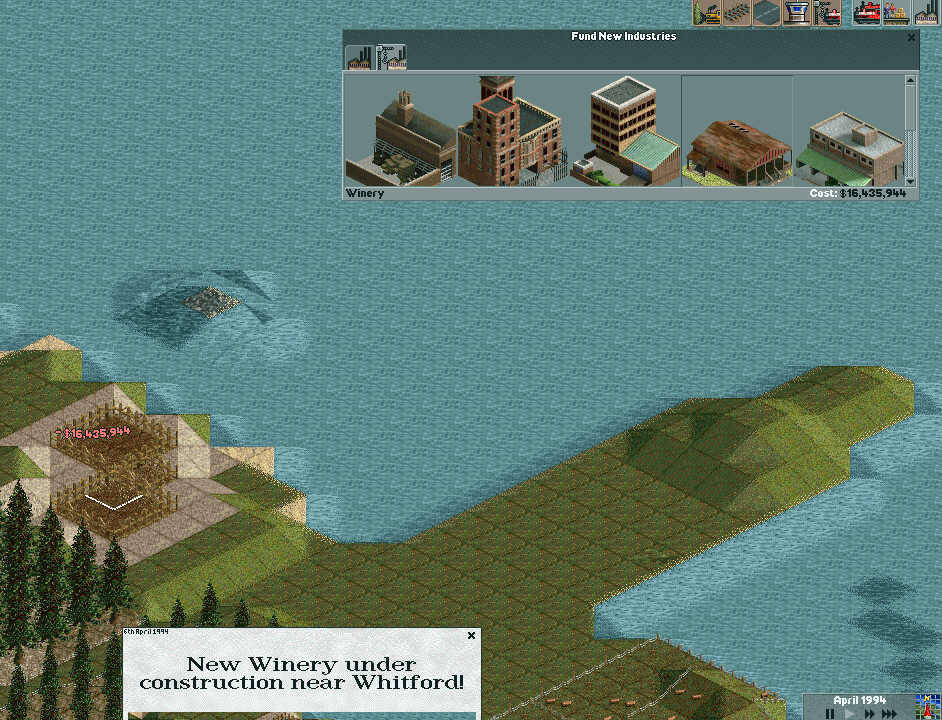  Edit: Open the image in a new tab to see the detail properly. Jaguars! fucked around with this message at 06:51 on Apr 30, 2016 |
|
|
|
I'm pretty sure some of the junctions are larger than actual towns at this point.
|
|
|
|
Yep.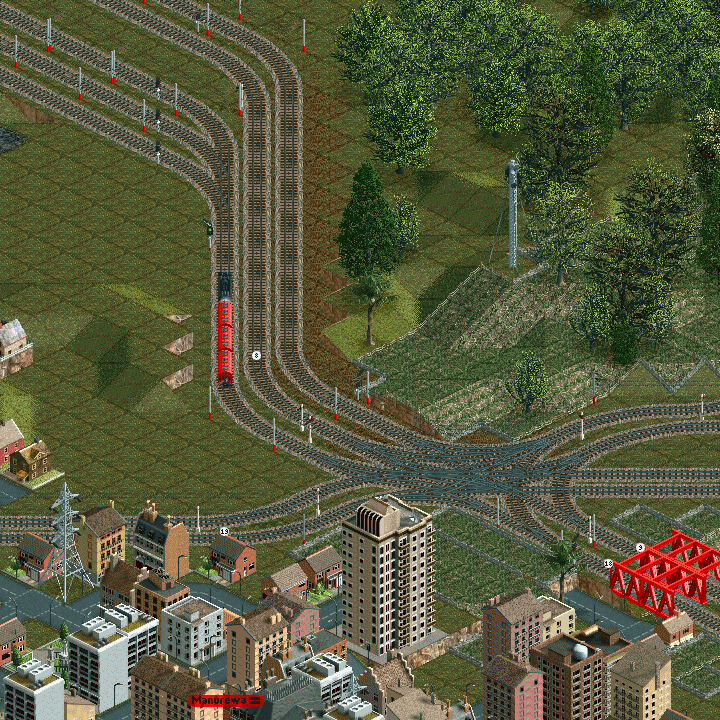 I wonder how many unnecessary movements are in this junction, but at this point I dursent remove any. Manukau sector might be the only railway in the world where the qualification for maintenance of way guys is a masters in engineering.
|
|
|
|
I just learned what a "Foamer" is. 
|
|
|
|
Galaga Galaxian posted:I just learned what a "Foamer" is. Hey - At least he's got passion! North America 3 1941-1947 Click here to name a vehicle!  Ok. I managed to get Baton Rouge to increase from 2000t/m, but about a month after it cut production 3 times in rapid succession and closed down! It peaked at 3000t/month, but I'm not sure if it even reached peak production. Then I found that I hadn't recorded the session :smack:. So here's the second try. 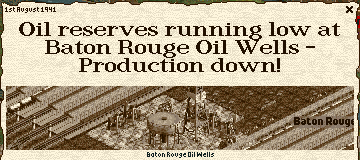 TIme to adjust everything again! 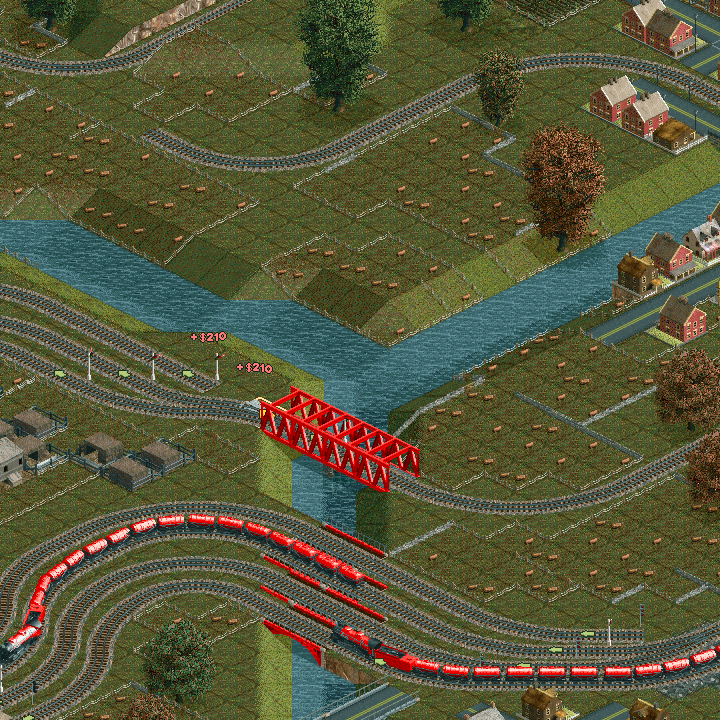 One easy ajustment is to remove a couple of entrances to a station, it makes sure that only a couple of trains load up at once. When times are better, it only takes a couple of seconds to connect them back up. 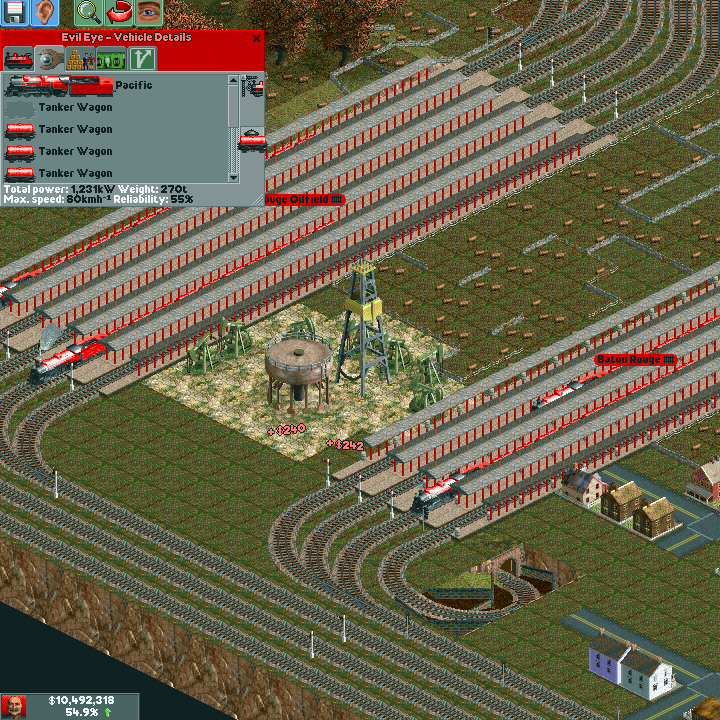 I sell 4-5 tank cars from all the short haulers. 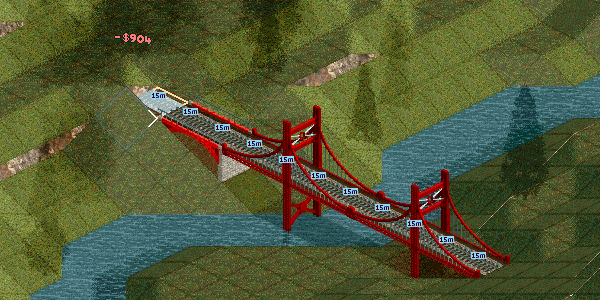 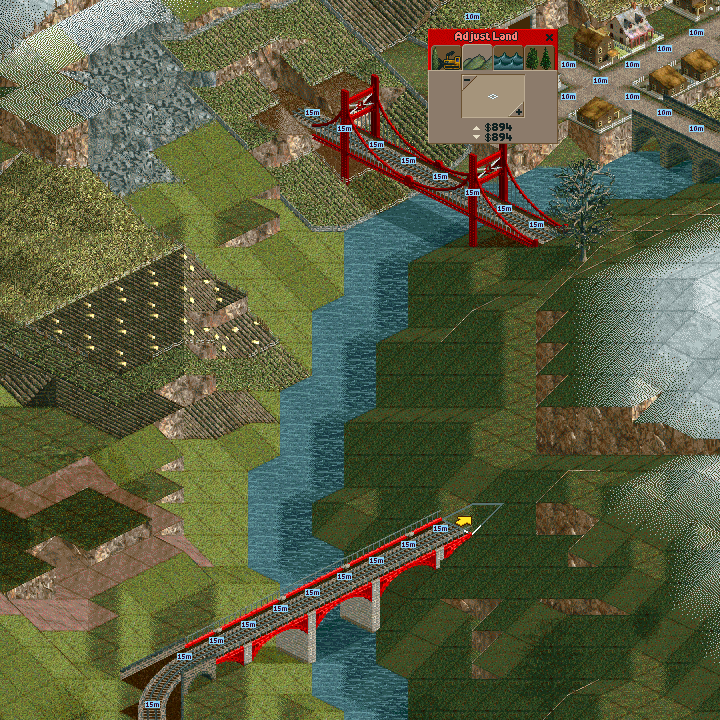  Adjustments made, I'm filling in some time by building some sweet bridges from a coal mine near Cincinatti to Detroit, when production is back up. 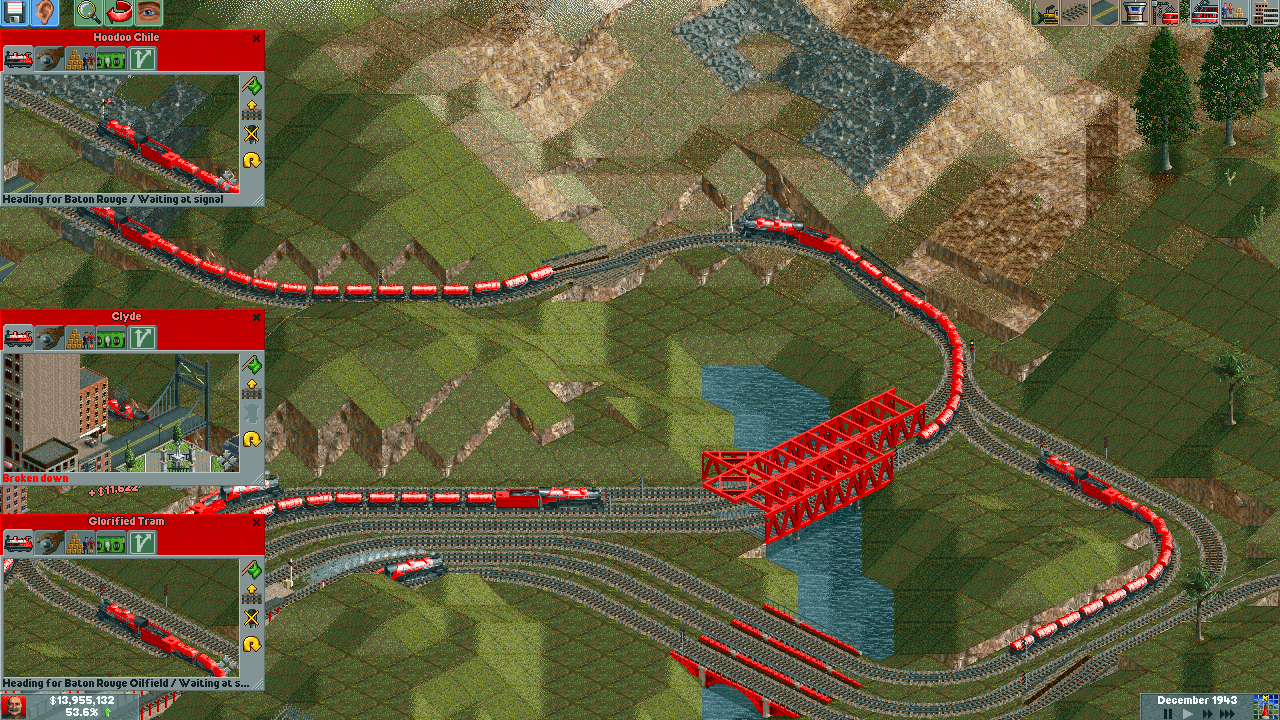 Now it's necessary to buy all those tank cars again! The station exit at Montgomery gets an upgrade so trains clear the station before causing a traffic jam. 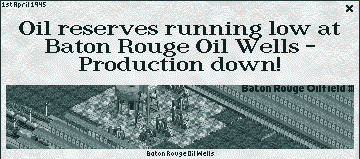 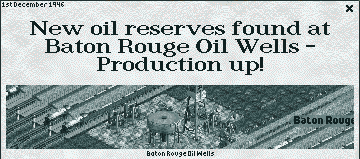 I must be on the borderline for efficiently haulling 2000t/month. 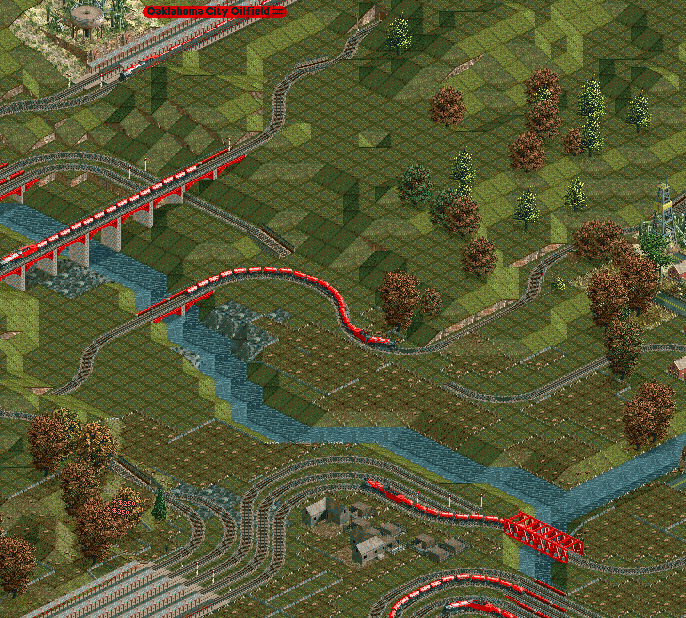 Things are once again looking busy. 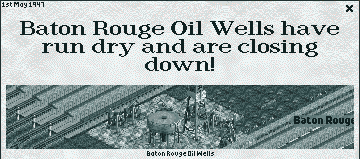 Damnit! I guess this well is just fated to close down in 1947. Since more than 30 of my 48 trains serve the well, there's not really much point in going on. Annoying, I think we could have got up to the next tier or two between squeezing in another line and arrival of diesels and larger tanker cars in the early 1950s. 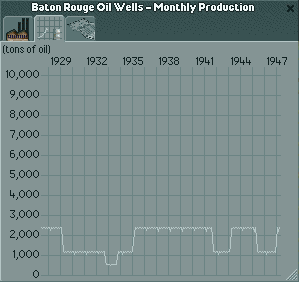   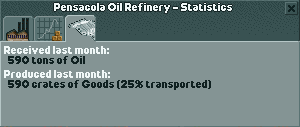   It's a real pity, I was really proud of the secondary goods network I built up, it worked really well delivering goods right to the tip of Florida. I don't think I've ever made one so effective, and I was laying the foundations to create a similar one to cover New England in spare moments. 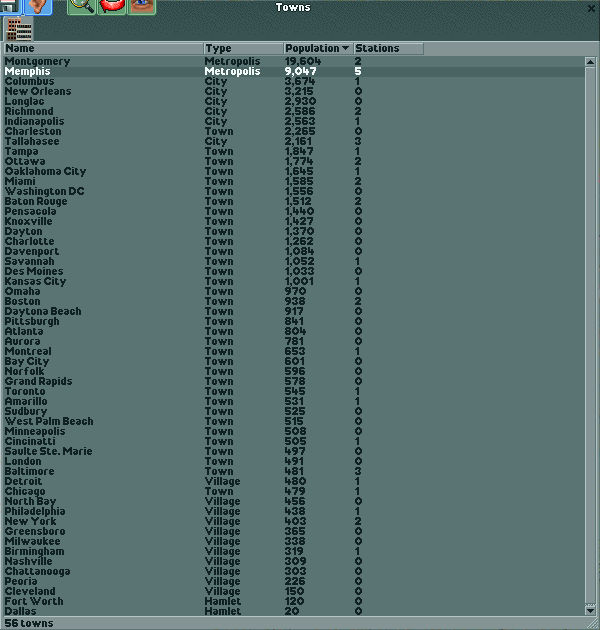 The two Behemoths are the towns most affected by our activities.  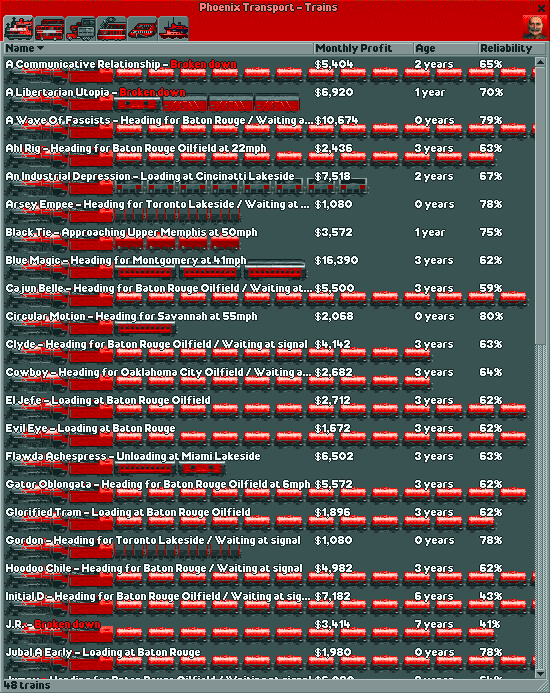   The roster. 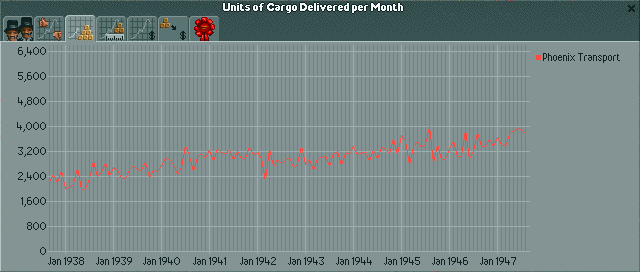 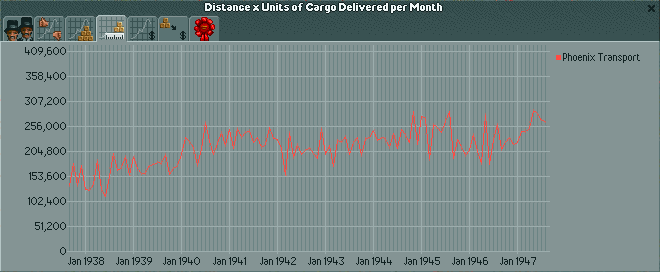 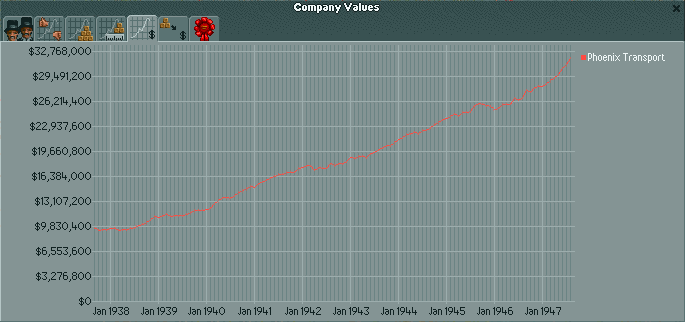 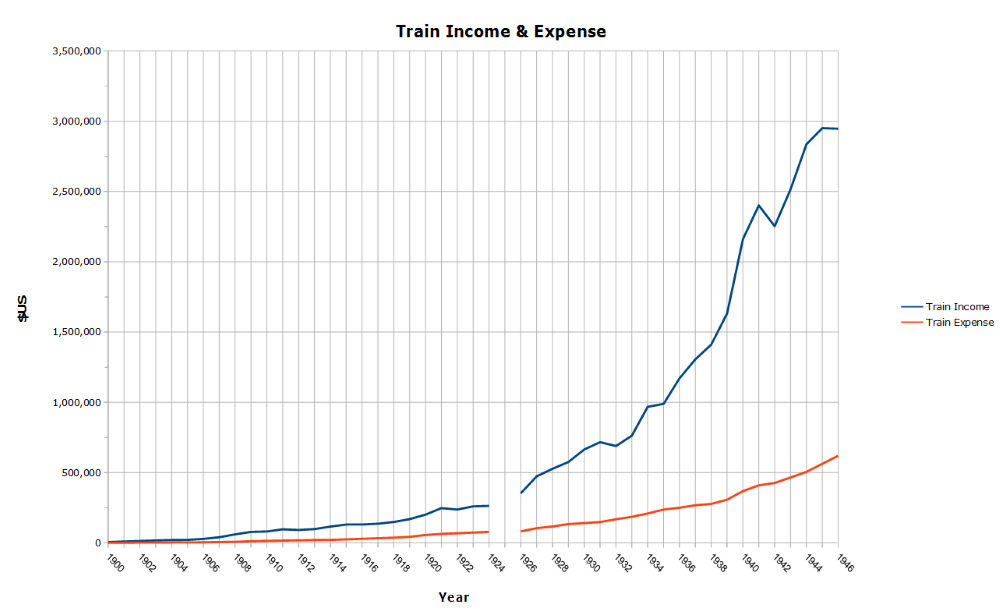 Unfortunatly, I'm afraid I couldn't get the finances from 1925 due to the points that I saved at. 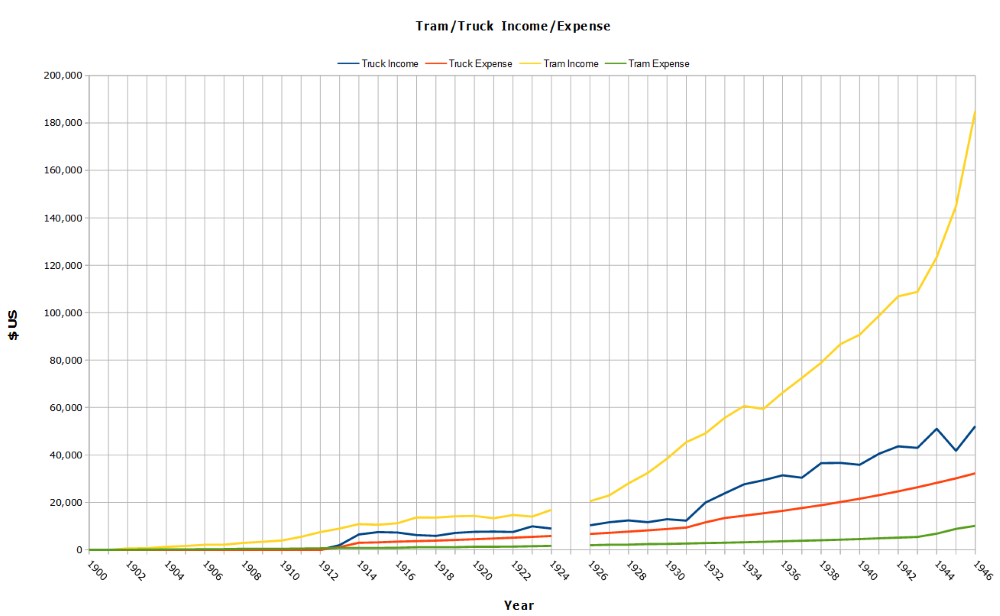 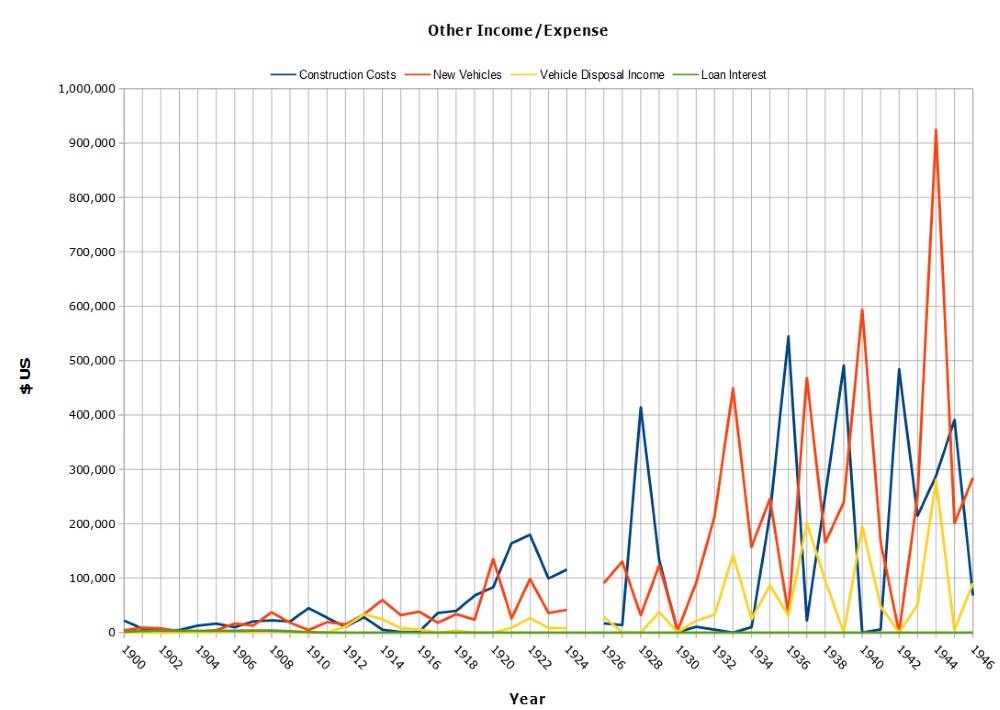 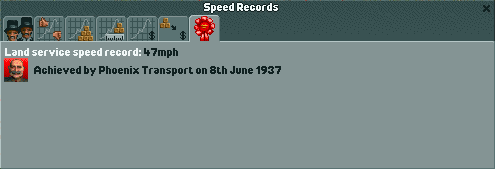  The amount of Oil hauled is far in excess of anything hauled in Auckland in 1997! Sooo that's that for North America. I might create a custom map with an ideal setup and see it I can max out an industry in ideal conditions sometime soon.
|
|
|
|
Galaga Galaxian posted:I just learned what a "Foamer" is. You mean this guy? https://www.youtube.com/watch?v=p1GnG5dwCqs
|
|
|
|
He may have been referring to this video from the OP as well. Discovering that theres a whole genre of these videos... ...it unnerves me a bit.
|
|
|
|
So, is it some running joke, or do they actually call themselves foamers?
|
|
|
|
Jaguars! posted:Discovering that theres a whole genre of these videos... ...it unnerves me a bit. There's even parodies of the genre! https://www.youtube.com/watch?v=tInDH2FeXaM
|
|
|
|
Pierzak posted:So, is it some running joke, or do they actually call themselves foamers? I first came across the term in the Locomotive insanity thread in AI. I don't know if it refers to all trainspotters or just the exuberant ones. Decoy Badger posted:There's even parodies of the genre!  I was going through the older part of the thread last night. 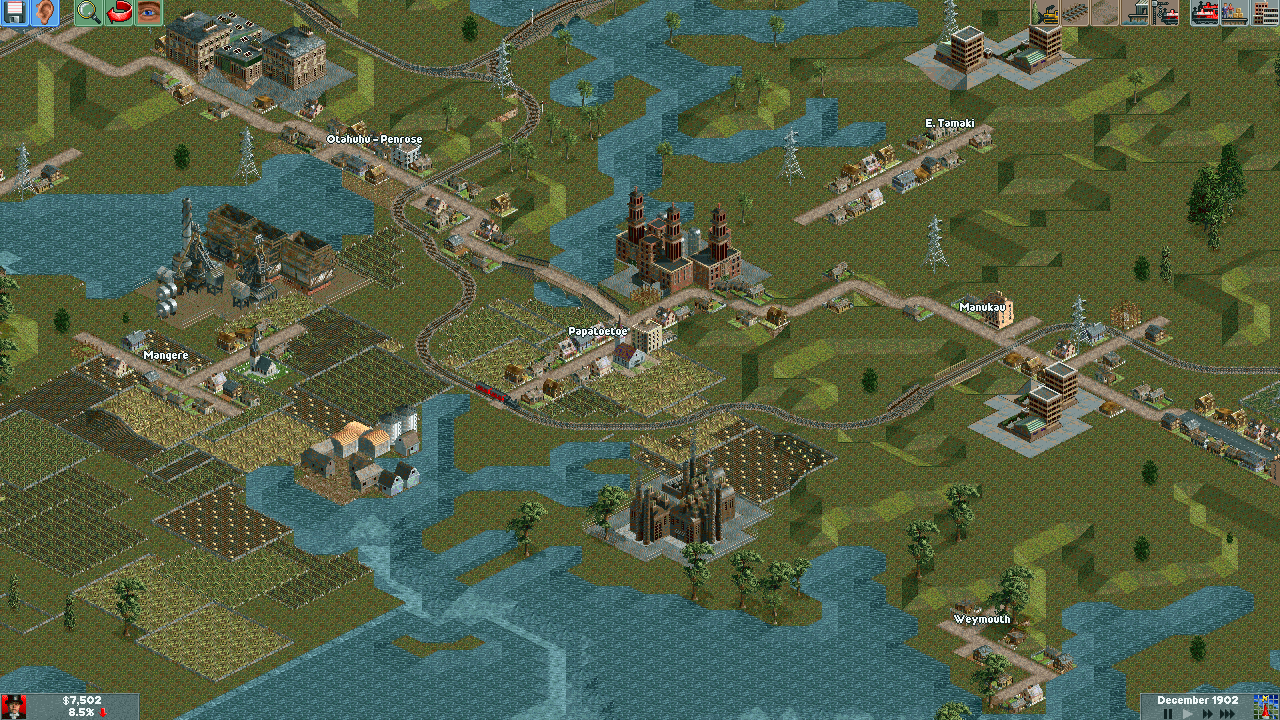 It's so cute! What a monster it grew into.
|
|
|
|
1997-2006: Not with a Bang, but a 5-Chime Locomotion Soundtrack - Techno Torture  Let's cap it off with a fitting final goal: Transport passengers the full length of the map, from Port Waikato in the South to Army Bay in the North. (Suggested by Xelada) 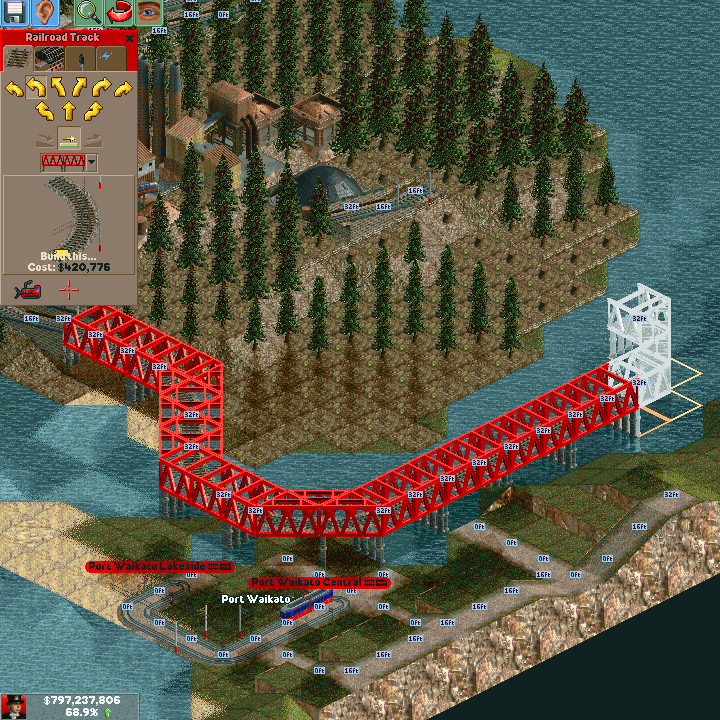 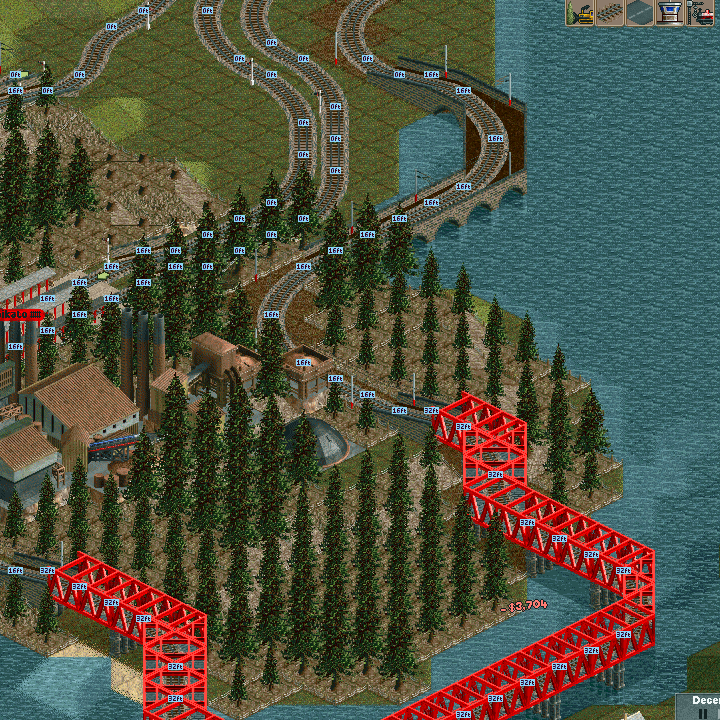 This ugly structure is necessary down at the Port Waikato end. 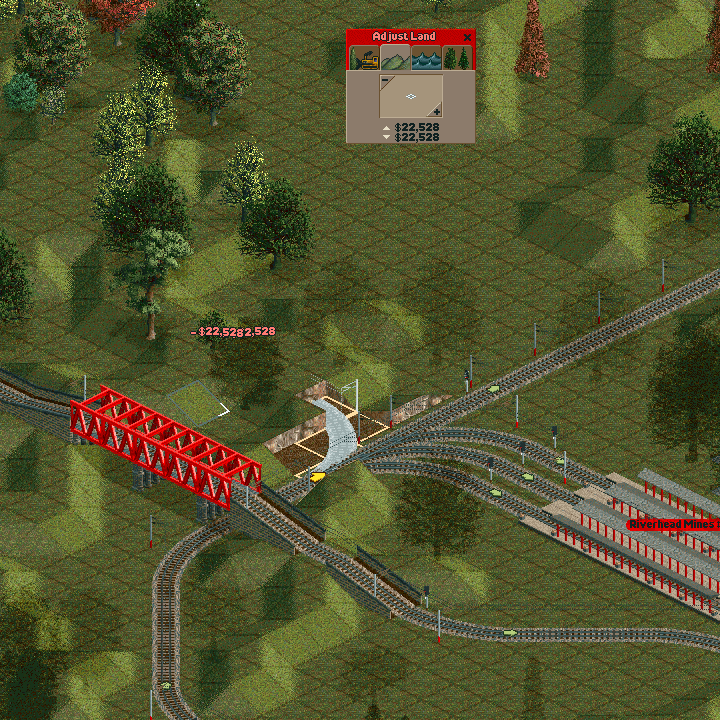  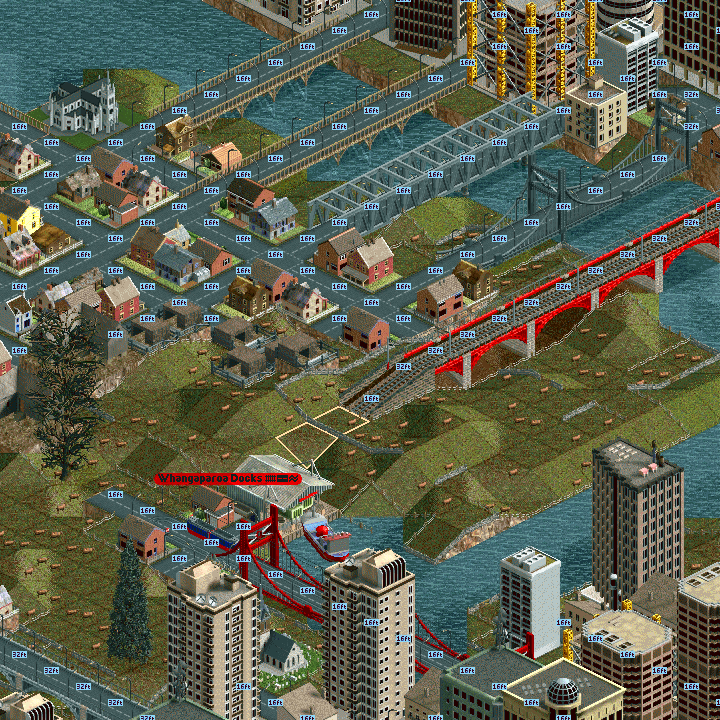 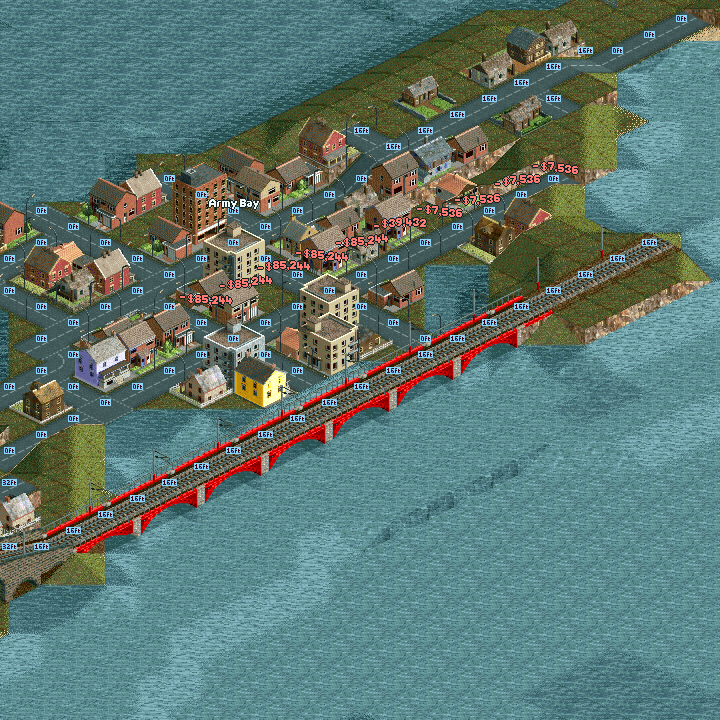 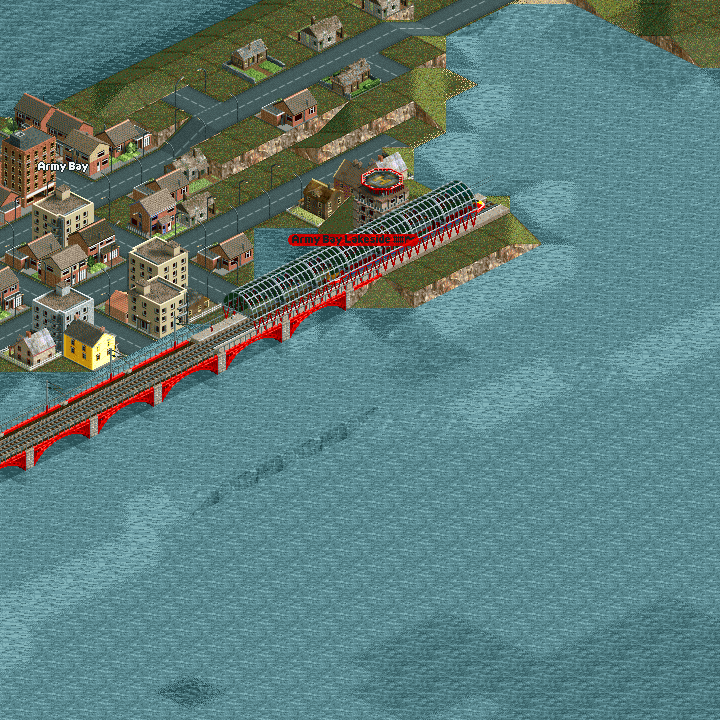 While up North, to get to Army Bay you first need to go around the Montsrous Dairy Flat. 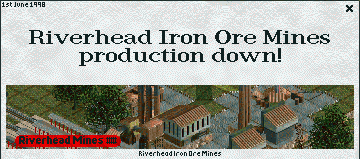 Some of our mines seem to be well enough serviced now to go up and down in production. 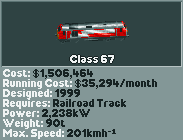 The final diesel is of british pedigree. 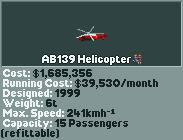 Only the second helicopter in the game! Er... I forgot to record the bit between 1999 and 2000. Not too much happened aside from more upgrades to the entire fleet, and the Steel mill at Otahuhu closed down, necessitating the selling of one of our trains and Burgundy closing down a bunch of lines. 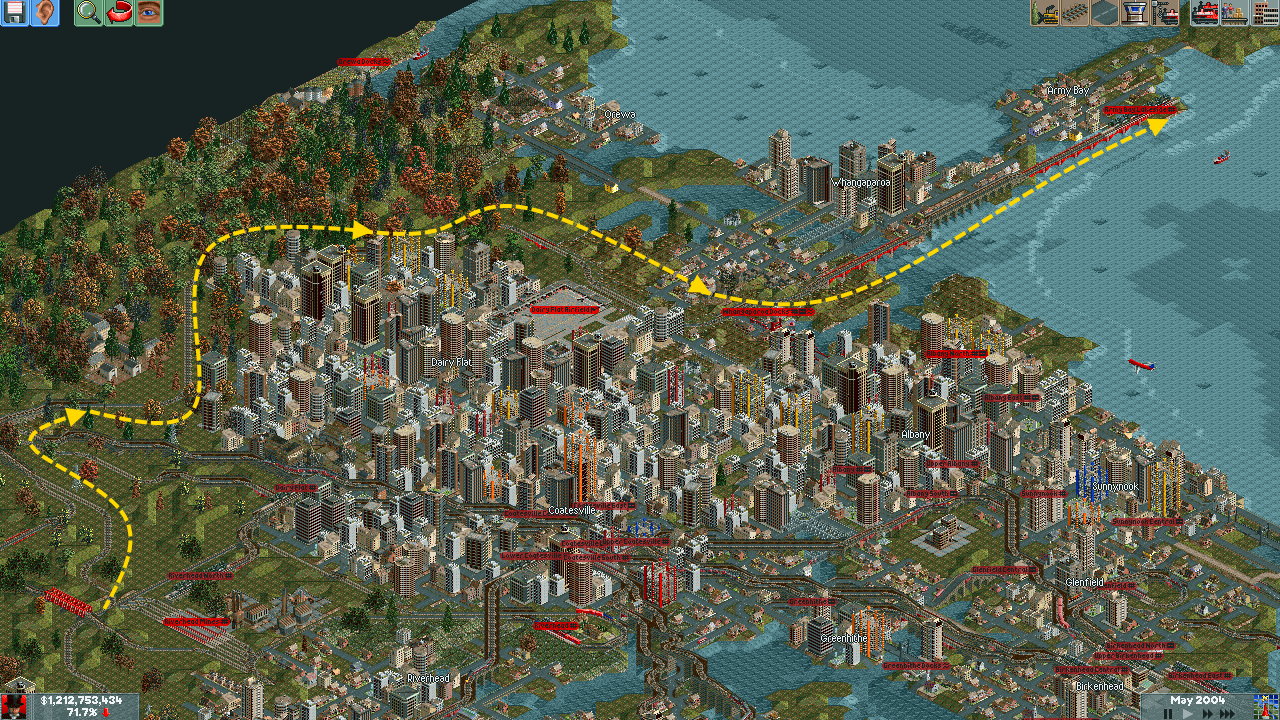  Anyway, here's the final railway as built. How the %#&# I got a non-stop GIF run first time round is almost beyond belief. As you can seen, the railway isn't exactly high speed. 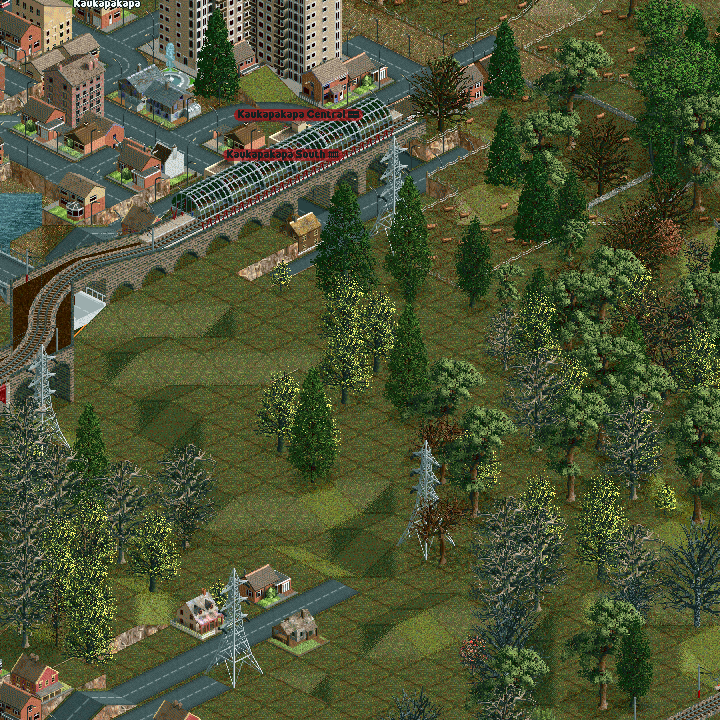 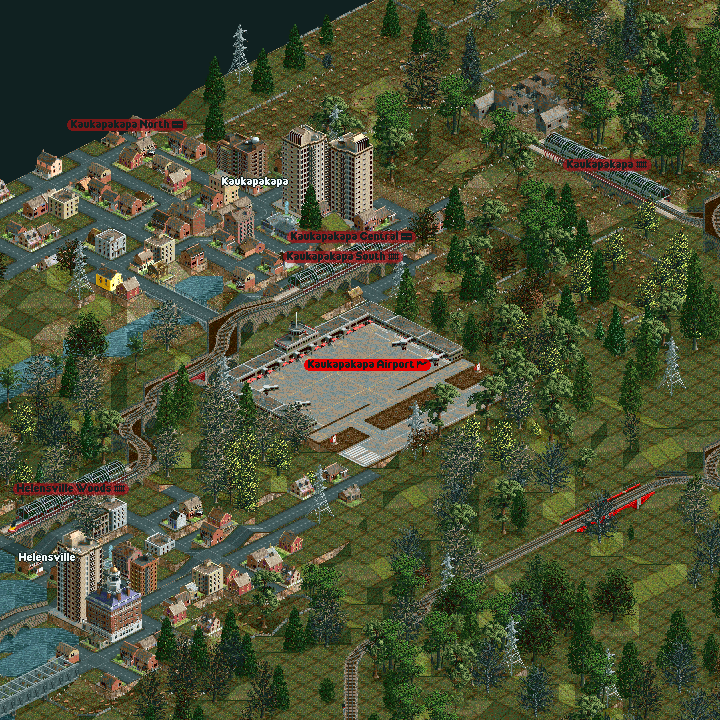 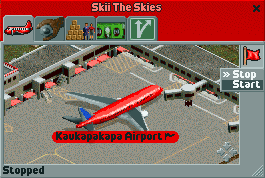 Up North we put in another airport to service the twin towns of Helensville and Kaukapakapa. 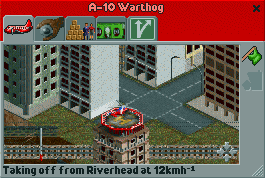 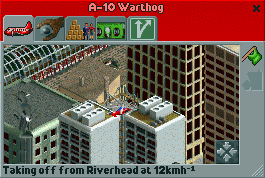 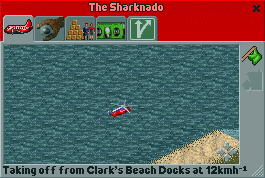 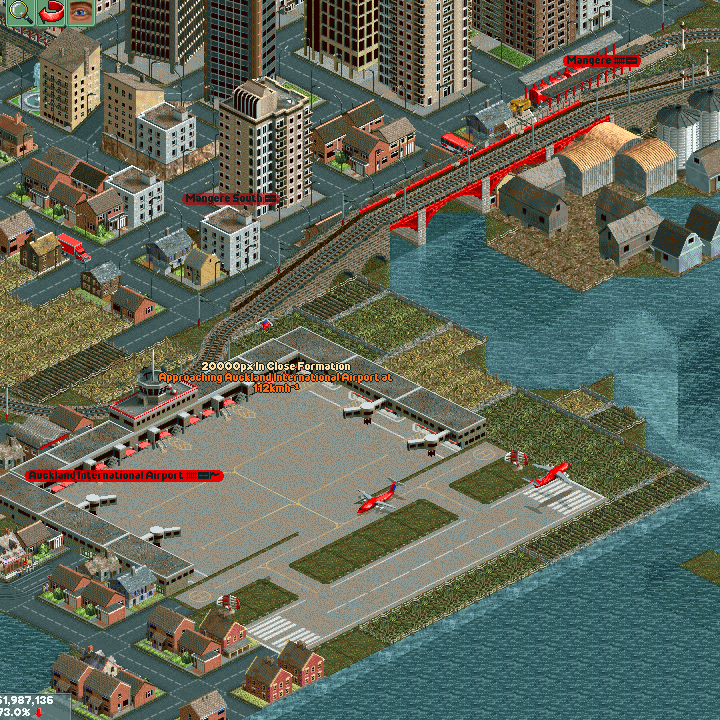 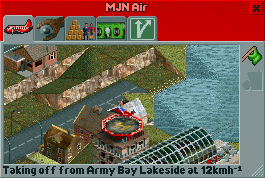 I put in one helicopter and realize that they are great for small passenger services to industrial stations where passengers would otherwise be an unwanted nuisance. I wish I had thought of doing it earlier! 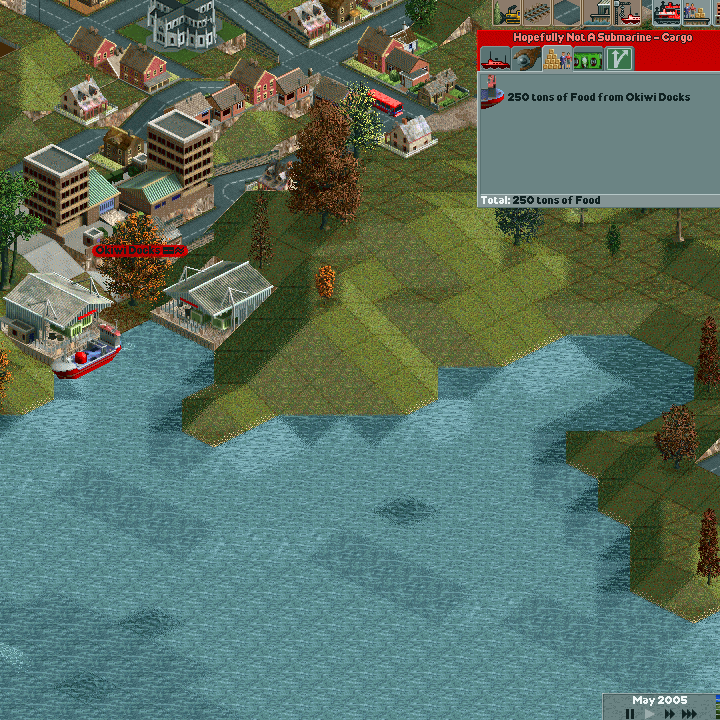 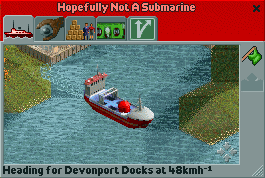 Enough food goes to Great Barrier Island to supply a ship or two carrying processed food, so I expand the harbour there. 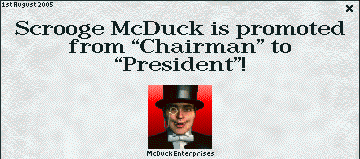   While tying up a few loose ends, we get the A380! So we grab one to finish up!  Well, that's more or less it. To wrap up I'm going to do a state of the game post, and I'll also look at doing a max production experiment this weekend before we call this LP done. Jaguars! fucked around with this message at 12:13 on May 6, 2016 |
|
|
|
I hope the state of the game post includes a giant screenshot of the whole map.
|
|
|
|
Wow. Watching that plane just whipsaw around was kind of weirdly terrifying.
|
|
|
|
Aw man, the A380. It is to extreme capacity what the Concorde was to extreme speed... and look where that ended up. ANYWAYS:Glazius posted:I don't have any requests other than, before this is done, find something else you feel is worth talking about. I love me an effortpost. Glazius, my friend, you have no idea what you just unleashed. So Jaguars! is wrapping up his LP (which I can’t thank him enough for doing! TT-type games deserve more LPs) and I felt like I wanted to show him my thanks for not running me out when I sperged out about airplanes. So, have a personally-inspired piece or two…. Or three: Part one: The Fastest Airliner in the World* *for a time So the running theme for these pieces is going to be “aircraft with which Spaced God has worked,” just because I feel that some stuff I’ve worked on has some interesting history behind it. They also were in the shadow of the big guys that got to get featured in the game. Our first exhibit has us going back to only a few years after when we left off from the Comet piece, around 1956. The Jet Age was now well and truly “a thing,” and in America companies like Boeing and Douglas had thrown themselves at the idea of an American jetliner. Meanwhile, Convair existed. Convair was a subsidiary of the aerospace conglomerate General Dynamics (bought in 1953-ish), and they were mostly known for making things with one of two properties: unique, fast things or extremely boring things. On the former end, you had your delta wing fighters and bombers like the F-106 and the B-58. They also had the B-36 Peacemaker, the only American aircraft to carry an operational nuclear reactor and also one of my favorite airplanes. On the other end you’ve got their only forays into civil aviation, which were regional turboprops like the CV-240 family, which is only notable for killing Lynyrd Skynyrd. But Convair saw the jetliner revolution we talked about last post and how much bank it was capable of making, so they threw their hats in the ring. They saw that the Comet, 707, and DC-8 were all hitting the same market: large people movers over long distance, and that the regional market was being left out. Logically then, there must be a market for a small, low capacity, short-to-medium range jetliner that can get people to places fast! Thus, an idea was born. The aircraft was pretty neat. It took four civilian-converted J-79 jet engines (the same jets that powered military aircraft such as the F-4 and B-58 to supersonic speeds) and strapped them to a 39 meter long fuselage with wings spanning 36.5m. It could carry 110 pax 4400 km at 535 knots. You’ll notice I have yet to actually say the name of the aircraft, and that’s where things get funny. Over the three year design period of the project, Convair went through like a half dozen goddamned names. The first sketches were named the Skylark, then the Golden Arrow (but it was too close to Continental’s trademark on Golden Jet), then the Convair 600, and finally the Convair 880. Those two numbers both are because the aircraft cruises at 600 mph/880 feet/second, the fastest cruise speed at that time for a jetliner (granted there were only, like, 3  ). ).Convair presented their idea to several airlines, and when Howard Hughes (who owned TWA) saw the 880, he was loving in and ordered 3 on the spot. Hughes got involved in the design process (as he was wont to do), helped fly some test flights, and by 1960 the first 880’s were in service with Trans-World. A couple other airliners picked up on the plane, including Delta, Cathay Pacific, Japan, and a few others. Hell, the Navy converted one for a tanker and Elvis even picked one up for his own personal plane.  A Convair 880 on the takeoff roll. A lot of times when the 880 took of, the four CJ-79s would belch smoke in their wake So by now you’re probably wondering where everything goes wrong and why you haven’t heard of this thing, and to be honest things went bad from square one. The engines they used were ungodly loud, inefficient, and smoky. This is because those engines were originally used on military planes which were mostly designed to go fast and not give a gently caress about fuel efficiency. Moreover, the 5 abreast seating setup wasn’t particularly liked by any flight attendant. The biggest problem, though, was that the niche Convair tried to fill existed, but it was REALLY small. In total only 65 -880’s were built, and only 37 -990’s (Convair’s desperate attempt to make their design better) saw flight. At the end of the day, the Skylark/Golden Arrow/600/880/990/whatever project produced a whopping $190M…. In losses. Convair got out of the air transport market forever to go back to making missiles and rockets and fighters and do cool poo poo like land on the moon, meanwhile the remaining 880’s were left to rust. Of the 65 -880’s built, I only know of six-ish airframes that are still intact-ish. Elvis’s plane, though not airworthy, is still floating around somewhere near Graceland. A few airframes were turned into corp jets until they either crashed or got scrapped, and one was even turned into a stripclub. The airframe I worked with was N803TW -- the same in that photo up there. She was a preproduction model (serial number 3) flown by Hughes to help sell the airplane. The museum owns the cockpit and the first-class bulkhead, and I did work restoring it to approximately what it looked like when it rolled of the assembly line in 1959.  3TW’s cockpit circa 2013, before restoration. I had started working at the museum in 2014 and by Summer of that year the restoration work really picked up. I remember scrubbing out the inside of the bare metal in August when it was 30C outside and 60C inside. Not a fun memory. The exterior of 3TW, probably around six months earlier than the above photo. Exterior work was done in Summer 2013, including the paint. Now, there’s a made-to-fit end cap on the cut end of the fuselage with power and ventilation holes implemented. Part two: The Martin 2-0-2 (equals 0) Let’s flash back earlier to 1945. There were a lot of post-war cargo airplanes coming back from the Pacific and European Theatres and converted to civilian use. The aircraft doing this in the biggest amounts was our good old friend the Douglas DC-3. Glenn Martin, president of the aircraft company bearing his name, wanted to build a replacement for these pre-war-era aircraft. Enter the Martin 2-0-2 (don’t ask me why it’s hyphenated). From the outside, it seemed like a pretty good design. 71 feet long, 93 feet wide, 40 pax/9,270lb capacity, and two Pratt and Whitney R-2800 Double Wasps produced 1,800 HP each to pull the plane to a cruise speed of 178 mph at 12,000 feet over 630 miles. An interesting note is that the horsepower could be increased by about a quarter through water injection, which was common on military aircraft but not civilian propliners due to weight issues. Here’s where things get weird. Not necessarily bad (yet), but weird. The design of the aircraft also had some quirks. You see, most aircraft around this time (including our friend Convair’s CV-270 and Douglas’s DC-6) were starting to become pressurized to give passengers more comfort and to allow a higher cruising altitude. The 2-0-2… didn’t... for some reason. Moreover, the aircraft lacked batteries. This meant to operate the electric airstairs in the back after a flight, you would need to keep at least one engine running -- because everyone knows nothing can go wrong when you have a bunch of civilians on a tarmac with running engines. 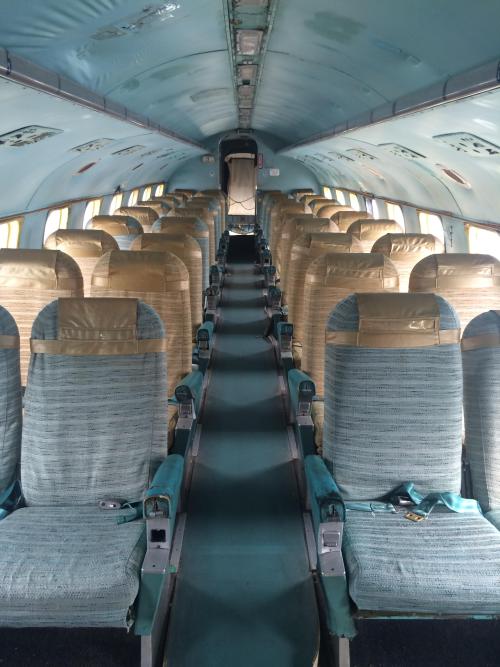 The interior of a Martin 2-0-2. Note the very small overhead bins -- they weren’t for luggage, but for hats!   The same airplane as above circa July 1962 flying for Allegheny Airlines. Electrical and pressurization issues notwithstanding, orders for the 2-0-2 flowed in. 137 orders were placed in the opening months from airlines big and small alike, including hard hitters like TWA, Northwest, and Delta. And now here is where things go wrong. The end of the 2-0-2 was a swift one-two punch. The first issue was the fact that the alloy used in the wing spars were prone to metal fatigue and corrosion. This led to a few instances of the wings just falling off mid flight. The entire fleet had to be grounded to fix this. The other issue was the fact that Martin had a clause in their contracts allowing the airlines to cancel their contracts at any time for any reason without penalty. This is dumb. These two issues, combined with the increase in faster, pressurized aircraft, put a nail in the coffin of the 2-0-2. Neither it or it’s successor the 4-0-4 were ever as successful as their competitors, and they faded into obscurity. A total of 47 2-0-2s were produced in a span of about 11 months. After they had been rendered obsolete they lingered around with charter airliners, but by the end of the day most all of them were turned to pots, pans, and tin cans. And by “most all,” I mean exactly 46. Today, only one 2-0-2 airframe exists in anywhere in the world, and it’s at the museum at which I worked. In fact, it’s also the same aircraft in the pictures up there... again! She served for Allegheny in the 50’s and 60’s, and was donated to the New Jersey Aviation Hall of Fame in the 80’s. Today, she’s not in the best of shape: her interior is cracked and faded, her paint chipped, and her wings clipped to fit her into the exhibit area. However restoration is actively underway to bring her back to her former near-glory.  The exterior of 93204, from about 10 years ago. The paint’s since chipped and decayed, sadly. 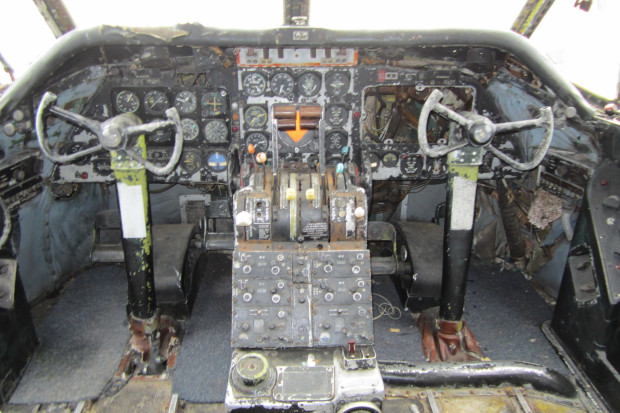 The cockpit of 93204 now. Hopefully we’ll get her back in shape. As an aside: I could rant for days about how the shapes of the knobs are completely different in this aircraft, which makes flying it at night super hard but I think this post is already getting long enough  Part Three: The Castle, the Porcupine, and the Gamble, all rolled into one Okay, so this isn’t an airliner. BUT! I feel that this should be covered because A) this is connected because it involves a gamblin’ company we’ve talked about before, and B) I am in love with this airplane. Let’s talk about the B-17! In 1934, the Martin (deja vu!) B-10 first entered service with the Army Air Corps (Air Force didn’t exist until 1947). It was the first all-metal monoplane bomber to be used by the USAAC and was pretty cool. The same year (don’t ask me why), the Corps wanted to prepare a replacement for their shiny new bomber. They had some pretty lofty (pardon the pun) requirements, too: Carry a useful payload for 10 hours at 200 mph for a period of ten hours, with “extra credit” goals including a range of 2,000 miles and an extra 50 mph to the cruise speed. The contract was sent to three companies -- Douglas, Martin, and Boeing -- with the winner to be determined via fly-off. A few years prior, Boeing had lost a contract (see a running theme with these guys?) with the Corps to make the B-9, a really loving slow, ungainly bomber converted from a mailplane. They had put a lot of money into that, and its rejection put the company perilously close to the financial brink. This time Boeing knew they had to do it right, and so they threw everything they had into this contract to create a design known as Model 299. The 299 took inspiration from the prototype XB-15 bomber and Model 247 transporter to create an absolute behemoth of a bomber. For comparison, the Douglas and Martin prototypes both were underpowered twin-engined designs which barely met the contract specifications. The 299, on the other hand, sported four P&W 1690 Hornet engines producing a total of 3,000 HP which could carry 6,000 lbs of bombs 2,000 miles to a target. While the competitors each were armed with three 30-cal (7.62mm) Brownings and very thin armor, Boeing’s original design bristled with six 30’s (this was later upgraded to thirteen 50-cal’s) and armor plating. It also featured the a nifty, top-secret targeting device called the Norden Bombsight. I could talk about this guy for another four or five paragraphs, but I’ll shorten it by saying it is the most accurate mechanical bomb sight of all time, capable of putting a bomb in a 75ft circle from 36,000 feet. At the first public display in Everett, WA reporters were baffled by the sheer number of guns and amount of armor, with one exclaiming “Why, the thing’s a flying fortress!” Boeing engineers heard this, and jumped on the name… the Boeing B-17 Flying Fortress. While getting ready to fly out to Ohio for the USAAC’s contest, the Fortress not only beat the other competitors to the airport, but also broke the world record for sustained speed during a cross country flight (2,300ish miles in 9 hours at an average of 252 mph). I can’t find any source to confirm this, but I assume the phrase “oh gently caress” was said in certain aerospace company meeting rooms. During the fly-off, it became clear quite quickly that Boeing’s entry was miles ahead of what Douglas and Martin had put together. The four-engined bomber demonstrated super-long range capabilities at speeds and altitudes which were unheard of at the time. Despite the setbacks of the B-9, everything was coming up Boeing. And then something awful happened. Again. (Last time I’ll type that, I swear!) During the second evaluation flight, the crew neglected to remove the gust lock before beginning their flight. Gust locks are devices which prevent winds from moving the control surfaces, potentially damaging them, so they’re basically trying to drive a car with one of those steering wheel locks. The plane took off, lost control, and crashed killing all aboard. Boeing’s only prototype (and only chance at financial salvation) was quite literally going up in smoke. It also turns out that “crashing your airplane” is one of the things that immediately disqualifies you from winning a USAAC aircraft contract. So now Boeing was, like, quadruply hosed: No contract, no plane, no test pilots that knew how to fly said plane, and no money.  Pictured: how not to sell airplanes However, the Corps were so impressed by the Fortress that -- even though the contract was awarded to Douglas -- 13 Fortresses were ordered. These aircraft were delivered in 1937 for operational testing, including the first intercept of an unknowing ocean liner by Curtiss LeMay. Some engine and fuselage upgrades later, the B-17A became operational in 1939. Over the next six years, this plane would become the posterchild of Allied airpower. We first starting giving them to the RAF under lend-lease, who instantly fell in love with the design. Once America got involved in the war, a total of 4,500 Fortresses were spread to bases in both theatres. Through daylight raids consisting of thousands of bombers, over a 580,000 metric tons of ordnance was dropped on targets in Europe, the most of any aircraft in the war on either side. German pilots were so intimidated by the aircraft’s defenses, they referred to them as fliegendes Stachelschwein, or flying porcupines.  A daylight bombing raid. Raids often consisted of as many as 1,000 aircraft loaded with bombs  A Luftwaffe model showing the cones of fire for each of the B-17’s 13 guns. Not a whole lot of safe places to be if you’re on the outside… 12,731 aircraft were built from ‘36-’45, and a lot remained in service for years after the war. Others were converted for civilian use, including airliners, firefighting aircraft, cropdusters, and cargo carriers. However, despite being the third most produced heavy bomber of all time, there are only 10 flying in the world today. I had the privilege of working with three of these guys when they flew into airports I flew out of, EAA’s Aluminum Overcast, Yankee Air Force's Yankee Lady and Collings Foundation’s Nine-O-Nine. I even got a chance to fly one, which is my only aviation-based claim to fame. You can see some of these flying relics too if you’re in the states. EAA, Collings, and CAF fly all around the country and offer rides and ground tours (There are airworthy -17s in France and the UK but I don't know their operations). Supporting these aircraft is very important, because most cost an exuberant amount of money to keep flying (EAA’s bird runs them somewhere around $2M a year) and we need to keep these wonderful pieces of history in the skies.  Nine-O-Nine, one of the last flying B-17s in the world. The symbol and letter on the tail was used to indicate the squadron the aircraft belonged to. The "A" in a triangle means she belonged to the 91st USAAF Bomb Group. So, there you have it: a lotta words (this ended up being WAAAY longer than I expected it to be) and a little bit of self-indulgence. As I said up top, big thanks to Jaguars! for the thread, and everyone for liking my little spice I threw in between updates (in this case it’s less of a little spice and more the entire spice rack, though). I hope I taught y’all a little bit about aviation history, because it’s super cool. If you want more, go to an aviation museum and talk to people because that’s how I learned most everything I know. Or, if you’re too lazy to leave the forums, hop on over to the Aeronautical Insanity thread. As always, if you have questions about anything I’ve talked about, feel free to ask or PM. But, I think the most important lesson we learned today is... Glazius posted:I don't have any requests other than, before this is done, find something else you feel is worth talking about. I love me an effortpost. Don’t give me free reign, or you’ll get a long, rambly effort post tangentially related to the game 
Spaced God fucked around with this message at 03:23 on May 23, 2016 |
|
|
|
Yeah, B-17s are pretty awesome. I was really sad when Liberty Belle burned a couple years ago. Anyways, thanks for the infodumps, and to Jaguars for the LP.
|
|
|
|
That was some quality B -17 history, thank you.
|
|
|
|
Thanks for the LP and the slices of history. I'm not sure if I'm gonna finish the last three challenges, I've reached my limit of 'get your rating really high with crap trains on a weak landscape' missions which sadly is almost all of them. It's a shame because a handful of the challenges are really neat (Aerophobia, Race to Read, etc) so the potential was there, not to mention it would have been fun to inherit existing companies rather than break fresh ground every single time. Or have a single challenge set in the 90s, and on and on. Still very glad I saw this LP and picked up the game. Also while playing I took note of when every song appeared to get the soundtrack in chronological order. Beyond thinking it was a really neat touch I don't know what to do with this information, but here it is: 
|
|
|
|
This was a fun little LP, though the layout of rail by the endgame makes me throw up a little. Surprised you can make the signalling work by the end of it.
|
|
|
|
Hi guys! Thanks for your well-wishes, suggestions and incredible informational posts. For my part, it helped to ensure that doing all the tedious screen editing and the like never really felt like a chore. Things got really busy all of a sudden this week, but I should have the financials and final reports this weekend. I'll also see about compiling some of the reader-contributed stuff into a post for archival, I think that we compiled quite a bit of info on game mechanics that have never really been publicly documented. DariusLikewise posted:This was a fun little LP, though the layout of rail by the endgame makes me throw up a little. Surprised you can make the signalling work by the end of it. Yeah, I think by the end we had pretty much all the practical routes sussed. It was still fun playing, but by the end things were very claustrophobic. Train Scheduling and waypoints really are a dark art. Since I last played this game I somehow picked up some knowledge on how path-finding Algorithms work, which really helped.
|
|
|
|
2006: For Whom the Crossing Bell Tolls Locomotion Soundtrack - Everlasting High-Rise Although most of these songs are compiled in a fairly basic sort of way, it's worth a listen to them on headphones. You'll hear quite a few production flourishes that tend to go unnoticed on tinny computer speakers.  Surveyor's Report:  Click for large version! 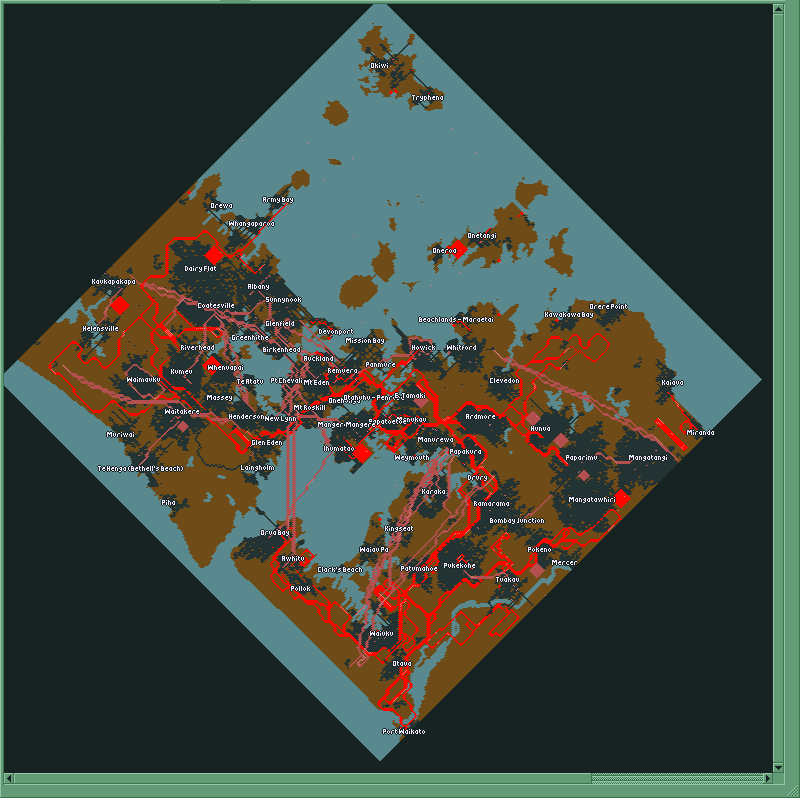 Owners map shows where the two companies concentrated. 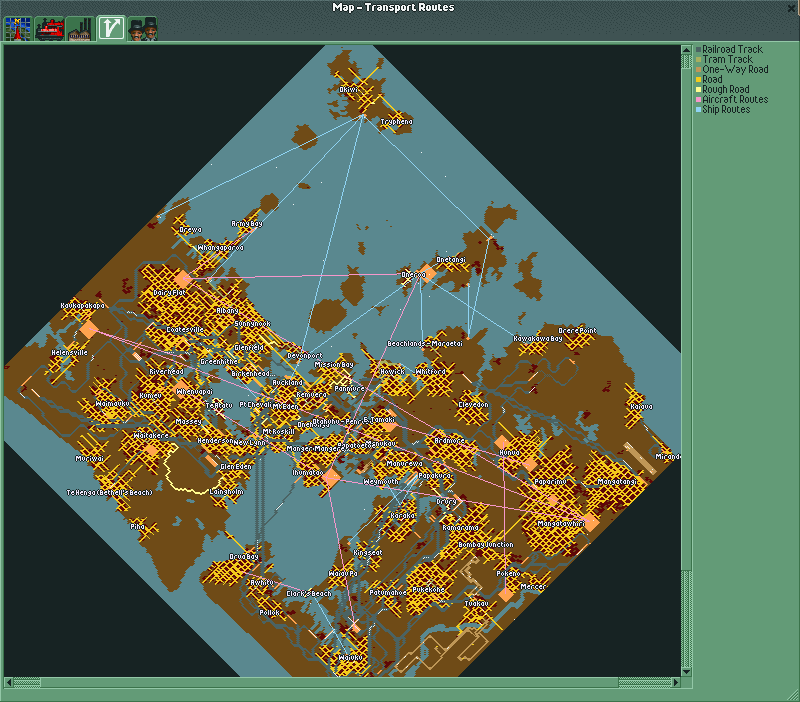 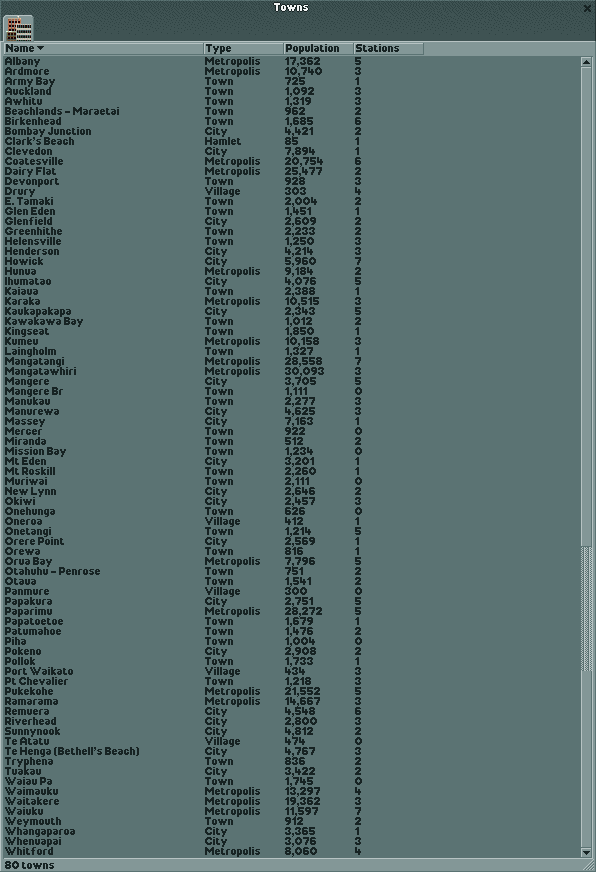 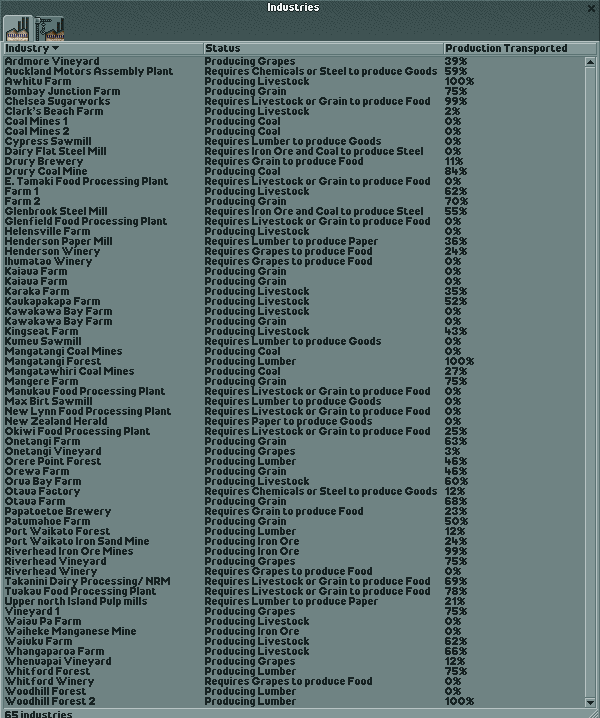 Finance department: 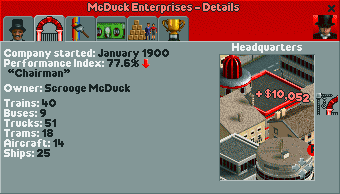 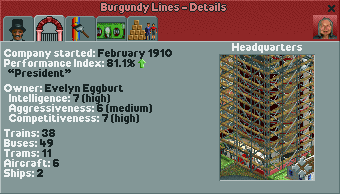 Eggburt went for buses where we went for trucks. I think she suffered quite a bit in the late game closures and reduced her train numbers. Certainly a few viaducts were removed from the most overcrowded areas of the map. 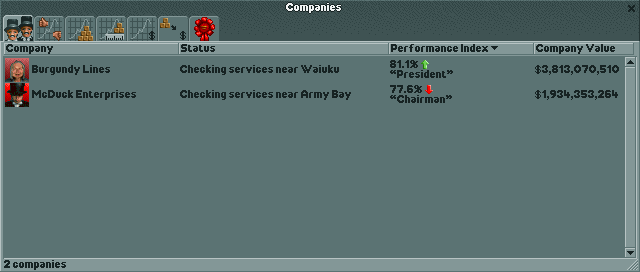 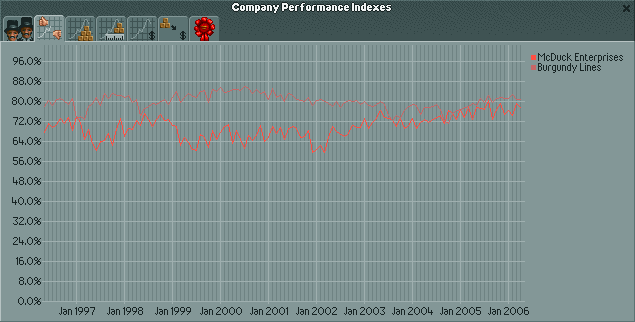 Turns out that we ended up pretty competitive in the later years. 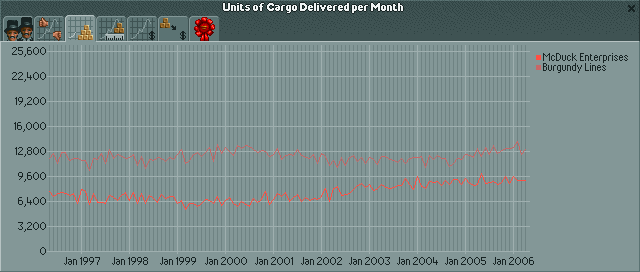 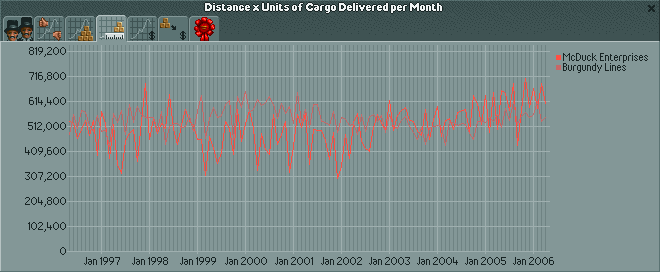 And it would seem that we go for distance over quantity compared to Burgundy. 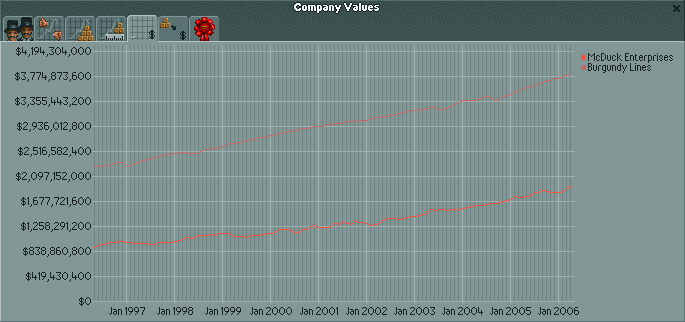 I think that perhaps Burgundy keeps a lot more cash where we tended to plough it all into expanding. 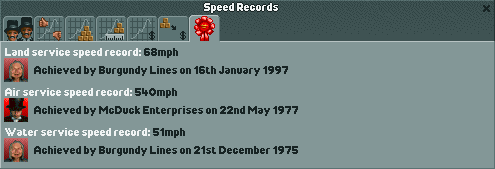 We still hold one of the most prestigious airspeed records.   I had to split up most of these graphs to get meaningful information, many of them just show a geometric sequence if 105 years is squashed together. 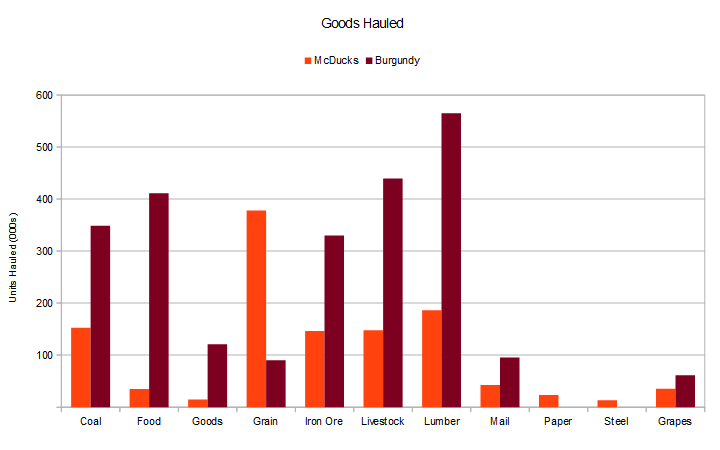 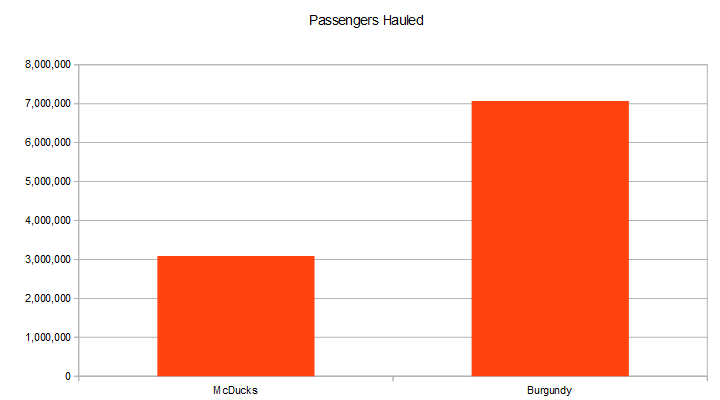 Burgundy beats up in many areas, but there were a few bright spots. We have a more general ability to haul just about anything!  Err, not my finest graph ever and Opencalc's chart tools proved annoying to use, but this graph was intended to show how much bang for your investment buck each vehicle type gave. Anything over one is making a profit. Peak return was 35:1 during the first year or two of train operation! Operations Department:  Train 'Rolling Coal' was sold after the Papatoetoe steel mill closed in 2001.  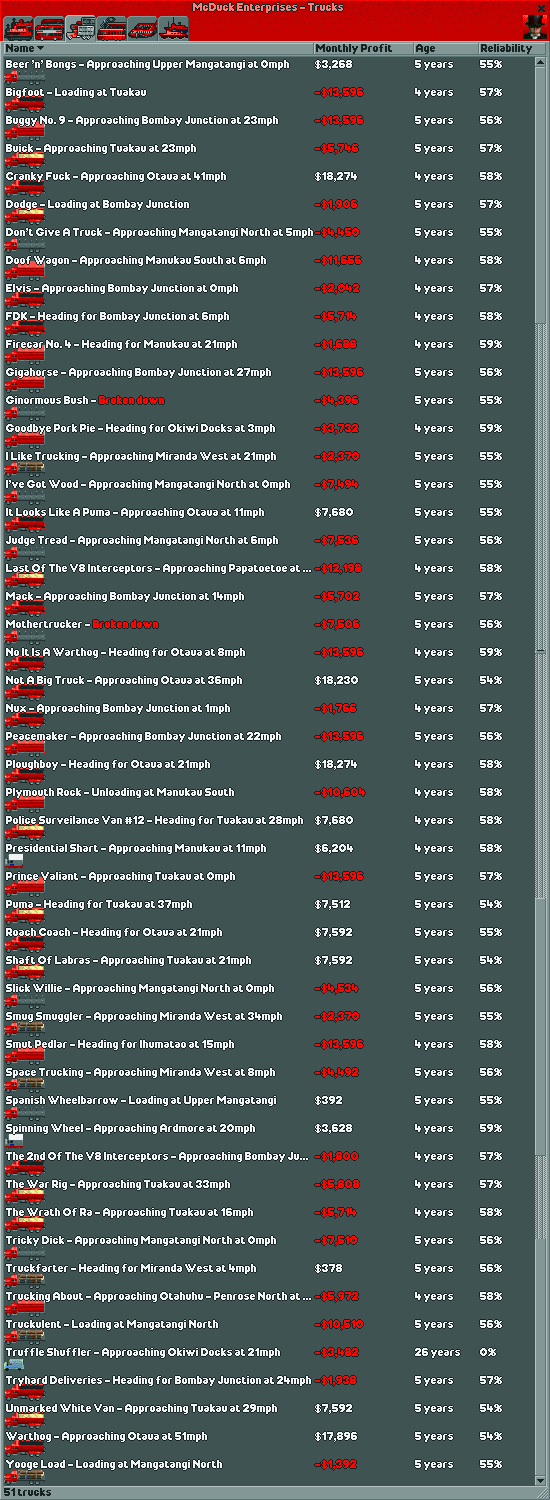 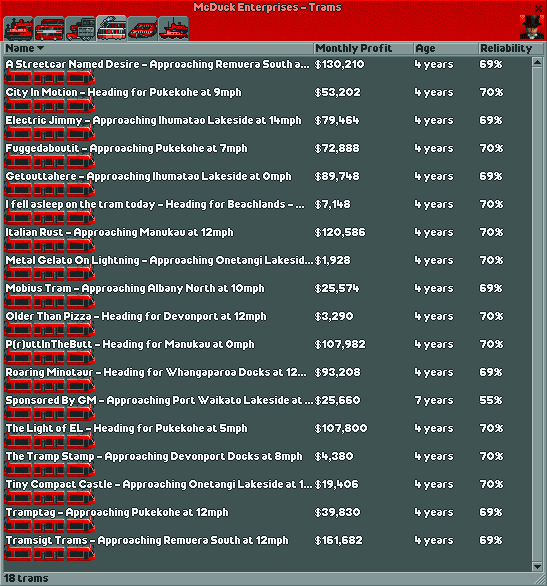  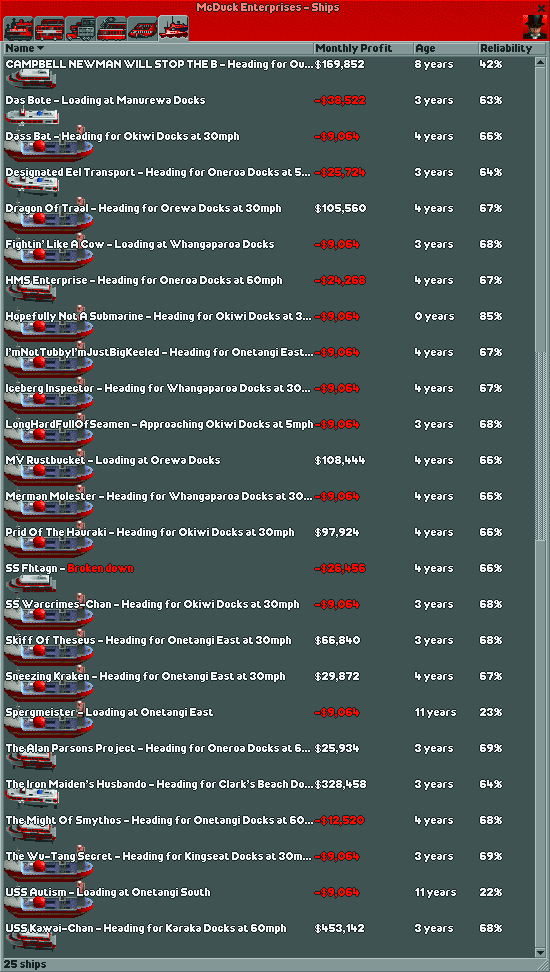 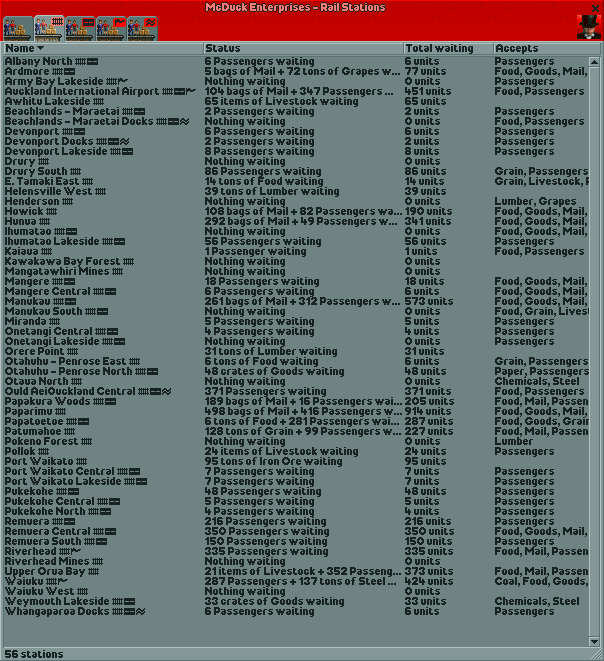 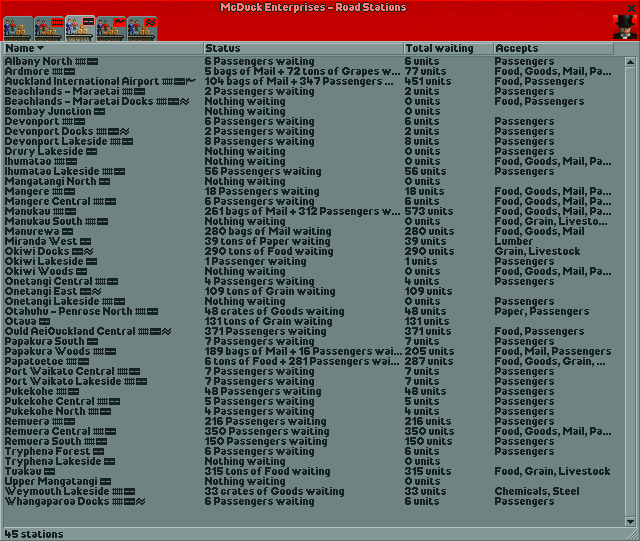   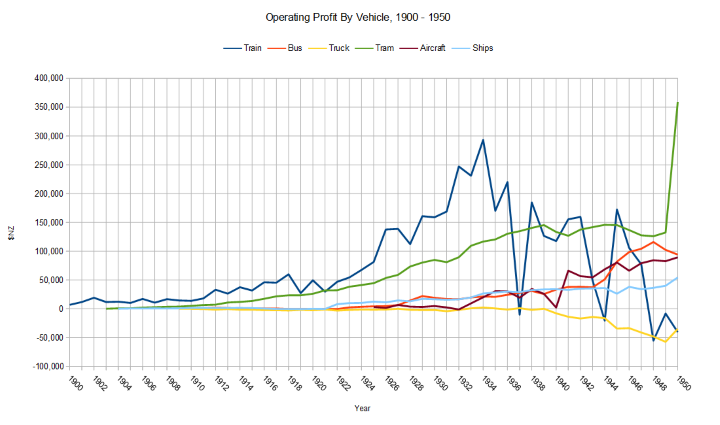 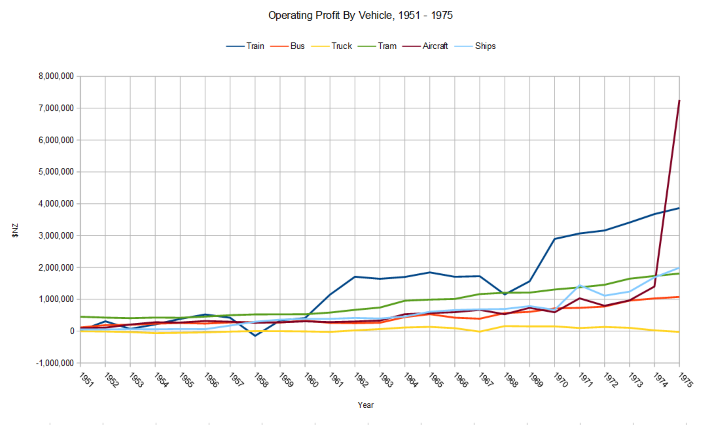 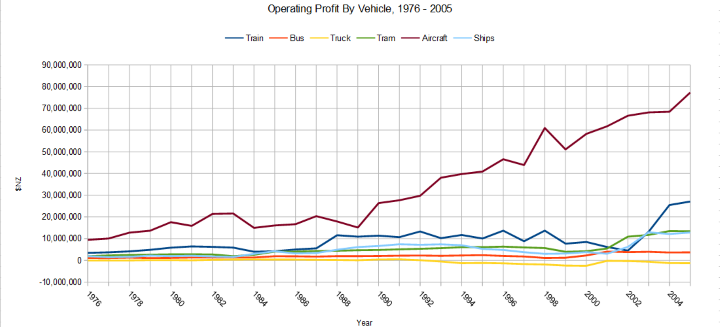 Some basic operating data. There were a few overlooked milestones such as the introduction of the coronation tram in the early 1950s and the ascendancy of widebody jets from the 1970s on. I was rather surprised that our trucks have been underperforming throughout, I thought that they had improved when the larger trucks started coming through in the 1960s. Manitenance of Way & Property: Cost, one tile of rail, 1900: $22 Cost, one tile of rail, 2006: $9886 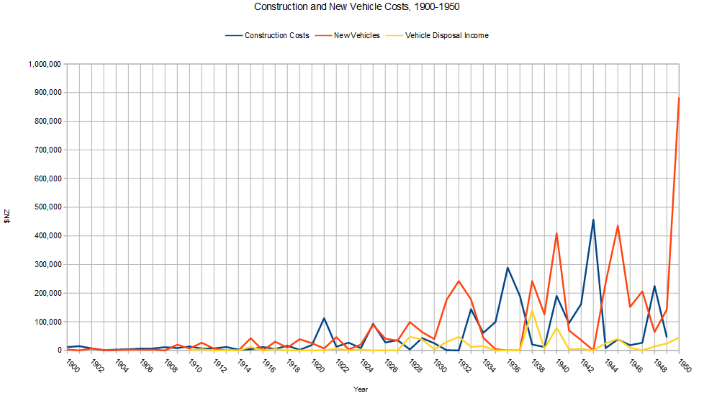  Construction tended to alternate with bouts of buying new vehicles. Sales of old vehicles tended to be fairly insignificant. We must have got rid of some real jalopies in 1942 because we hardly got any residual value back whatsoever! Construction eventually was reversed from the early years and was overshadowed by new vehicles.  While not complete, this is reasonably accurate. Perhaps Scrooge could have been more ruthless in certain areas, but he believed in the right of humankind to fill swimming pools with cash without the door being smashed down. Planning Department: Every railway must cross two roads.(Jobbo Fett) This was rendered moot because the rail was incorporated into a single network. By the end, virtually every railway had dozens of level crossings as the towns grew anyway. But it does make for an interesting challenge if one is building seperate railways. All rail has to be connected and moderately overcomplicated(Poil) Exception: Rail lines in a Achieved While the first few lines were fairly simple, I think that we can all agree that the final system was complex enough. Develop the island towns(Pierzak) Partially Achieved The towns on Great Barrier Island developed considerably, although by no standard do they count as metropolises. Meanwhile, the two towns on Waiheke Island stubbornly resisted attempts to change, including a brand new airport with the latest jets to serve it. Turn Devonport into a sprawling hellhole of the Pacific.(Oystertoadfish) Not really achieved Although I added a tram system and established a ferry service, I could have done more early on to develop the town by creating a few long distance routes. On the other hand, it was far from the rail system which made it hard to connect. Perhaps I should have invoked the Tiles can only be raised or lowered 1 height per project.(Velloxyll) Achieved Apart from the single network requirement, this was the one that had the most influence on my game. A one tile limit means that you can't dig into flat ground to build a tunnel, which is two levels high. I did comply with this the whole time, bar a cutting I made late in the game instead of a tunnel. When we built the Food plant out on the islands, we had to widen a few harbour entrances which had high hills as well. Found Auckland airport and build Auckland Airport(Xenoveritas) Achieved Yep, Auckland International is right where it should be. Whenuapai and Dairy Flat are also based roughly where real life airfields are. However, I can only regard this as a partial victory because I failed to make a TEAL joke during the appropriate era. (There were a few mentions of the Maritime division airfleet that were references to the Union steamship company, which ran it's own airline that was an early ancestor to Air NZ. Connect preferably by rail Port Waikato and Army Bay.(Xelada) Achieved right at the very end because the North grew some huge cities before I built and it's hard to dodge them and still have trains go the correct way. Develop the smallest hamlet into a bustling metropolis(Pea) Achieved Hunua started with 13 people and ended with 9,184, the 15th largest town, and the game ranks it as a Metropolis, the highest level. 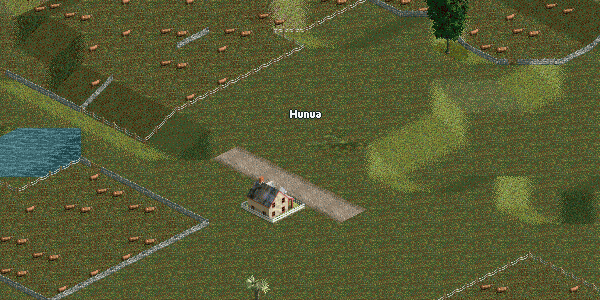 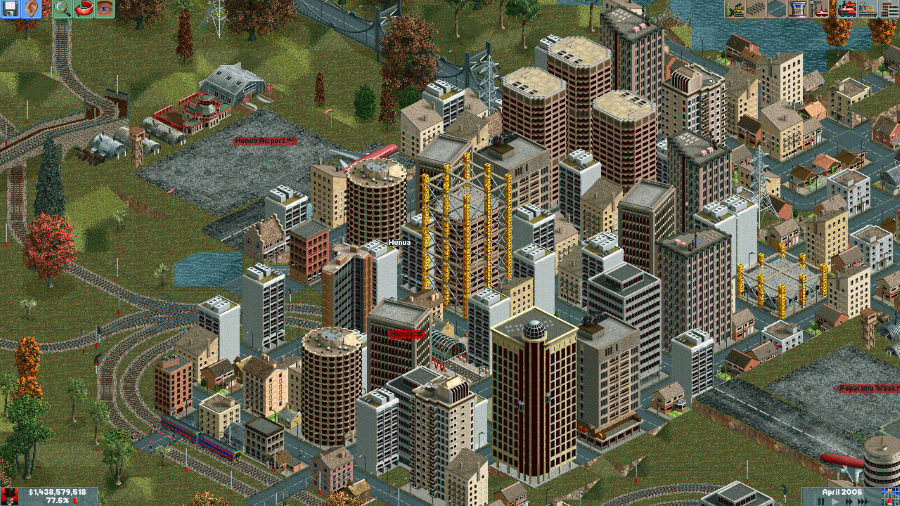 Dominate the South Auckland area by 1940(by vote) Partially Achieved We connected every industry by the time allowed, but there was no real way to get rid of Burgundy transport once they established themselves in the area. Connect every industry on the map by 1950(by vote) Spectacularly failed! Even in 2006, there still remain industries on the map that are unserved. I was way too ambitious here. R & D department: Over the past 105 years we have learned some stuff. A lot of the mechanics of the game aren't publicly documented, so here are some of the things we found out in the course of the LP. Weight of Passengers:The small carriage weighs 16t empty, and total full weight (20 passengers+2 sacks of mail) is 17t. The large one (48 passengers) weighs 34t fully laden. Both seem to get one person free, and then weight goes up 1t every 10 passengers. Mail weighs 1t per 16 bags. Transshipping: It is possible to transfer cargo at a station. The trouble is that the game doesn't track the cargo very well and it depreciates the load fully the moment it is unloaded for transfer. Ordering a mixed goods train to fully load a certain type of cargo prevents it from accepting other types.The Unload order also counts as 'Don't load this type of cargo here' Inflation: Is not dynamic. I found that vehicle prices were constant for the same time period from one scenario to another. Is it a constant rate throughout the game? Do different types of purchases inflate at different rates? Those are questions for someone else. Crash Exploits: I don't think any of the ones from TTD carry through. There doesn't seem to be any way to crash your opponent's locomotives, although you can still spoof AI trucks by building a train on a level crossing tile. Power vs Speed: Power is generally more efficient on routes except over very long distances. Baldwin locomotives in particular are more efficient than their predecessors, especially with a decent load on. Pathfinding: Trains use a straight line pathfind to get from waypoint to waypoint. It your trains keep getting lost, it's probably because they are taking a junction that veers in the direction of the straight line even if that's not the one that gets where it wants to go. Sometimes making junctions more square with straight approaches and 90° turns helps. Trains have an approach mode where they reduce speed and try and feed into the station platforms in an even manner. If the trains queue up on one platform, try evening out your entrances. Song debut dates(Thanks to Tomanton):  Mod Download: I've created a new version of the scenario with various improvements: -Removed about a dozen calibration marks leftover from building the map. -Removed several trains with duplicate stats. A couple of overpowered early diesel locomotives are gone. -Added about 20 Aircraft, representing the majority of commercial aviation in NZ. (Except for the early flying boats. I'd love to have them but no-one's made any) If you don't feel like downloading half a dozen modpacks, there is a vanilla version available too, the only file you need to download is the (vanilla).SC5 file 1. Backup the objdata folder in your locomotion install. If stuff goes wrong with your game, copy it back to start afresh. 2. Get the items in https://www.dropbox.com/sh/z7v9mymj...k86jVcQJla?dl=0 The scenario file goes in Locomotion/scenarios. It will appear in the 'Challenging' Section when starting a new game. The DAT files go in the Objdata folder. They are the modded objects. 3. Get this North American Mega-pack(136mB) which will install about a million billion SD-70 variants. Follow the install instructions, for my scenario, you should only need the cargo vehicles pack. 4. Enhanced Airport Pack 1.1:http://forum.locomotiondepot.net/download.php?id=24 Custom Church: Contained in dropbox folder. Original at bottom of page here Ford Transits: This was a german mod that I translated. The translated files are in the dropbox link. Original Download MK1 MK2 Version 2 also uses: Earth slopes: http://cache.locomotiondepot.net/view.php?item=32 Aircraft Pack: https://chrissawyerslocomotionword.wordpress.com/2015/02/05/airplane-pack-company-edition-1-0/. Be careful not to install it to C:\Locomotion\Locomotion, this joker set up his installer in an odd way.
|
|
|
|
It's weird, but the thing I find most charming about this game is the way the music cycles in and out as the years go by. I guess as a non-foamer that's easier for me to get a handle on.
|
|
|
|
Glazius posted:It's weird, but the thing I find most charming about this game is the way the music cycles in and out as the years go by. I guess as a non-foamer that's easier for me to get a handle on. Yeah, I really like it too. The only thing is that the early ones are prone to repeat too many times. The things I like most about the game are the little details of the world, the way that the newspapers, stations and signals all modernize, even though they have no mechanical effect on the game.  Early pilot version of the original transport tycoon I'd like to leave it to Chris Sawyer himself to sum up: Chris Sawyer - Introduction to manual posted:In some ways, Chris Sawyer’s Locomotion is a very simple game. The concept is basic: transport cargo and passengers from a location that produces them to a location that wants them. But the game is vast in scale and depth, where you can play in your own style and get drawn into the world you are building in, getting personally attached to your handiwork. It isn’t the perfect game, but then I don’t see that as the aim of my job — a perfect game would have no flaws, no character, no individuality. I try to create games that are unique and different in style, games from which the player can achieve satisfaction through construction rather than destruction, games with ongoing gameplay rather than a limited script or only a single definition of success. People are still playing Transport Tycoon 10 years after it was published — I hope that 10 years from now people are still playing Chris Sawyer’s Locomotion!
|
|
|
|
Looks a lot like A-Train. Man, I'd love to see that LPed.
|
|
|
|
Thanks for the great LP! I learned far more about trains and planes than I ever imagined I would want to know!
|
|
|
|
Edit: Oops! was trying to update the table of contents for achiving.
|
|
|
|

|
| # ? Apr 19, 2024 17:54 |
|
Pierzak posted:Looks a lot like A-Train. Man, I'd love to see that LPed. Afraid it won't be by me, I thing I've done enough train related LPing for the moment! Thanks to this thread, I did learn about quite a few transport games that I'd like to check out for myself, though. Decoy Badger posted:Thanks for the great LP! I learned far more about trains and planes than I ever imagined I would want to know! I was quite taken aback with the informational posts that a number of posters did. They were really awesome though! I've linked them in the contents post and I will see about getting them archived along with the rest of the LP. As a little post script, I've been playing a continuation of the US game trying to max out the industries. This time round, I used a custom scenario with only a few types of industry, making it easier to build up a rail system without industry closures wrecking everything.   So it seems like the limit is 3000t/month. I couldn't get it any higher and towards the end I was absorbing the output of both wells easily. With oil, you get a new tank car around 1960 that carries 60t each, which makes it easy. If there's any further production levels, the trigger must be fvery finicky, but I don't think that's particularly likely. Production rate doesn't just depend on collecting all the oil, if you set a huge train to just sit and fill up, the well is as likely to cut production as anything. The key is to get lots of train departures as well. The main pair of wells are serviced by 24 trains. 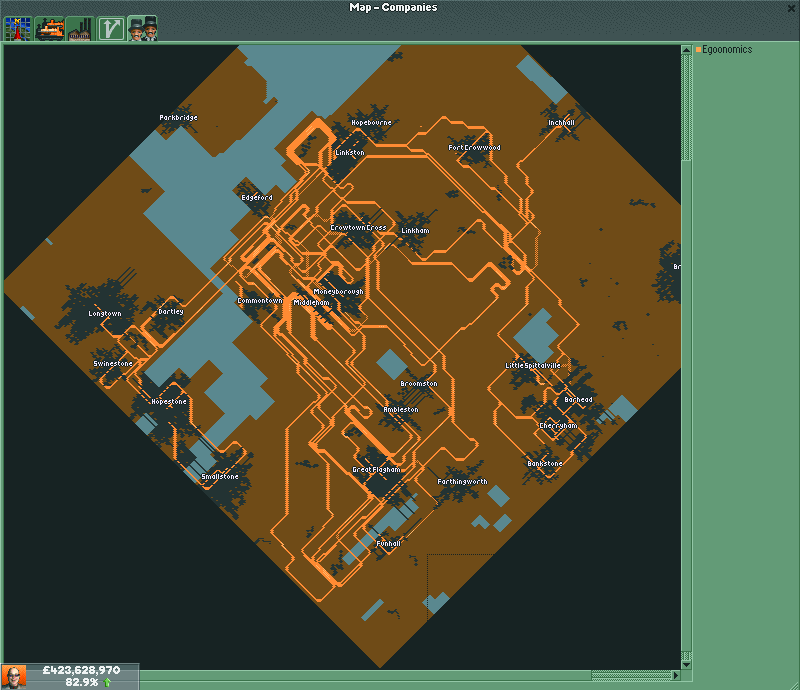 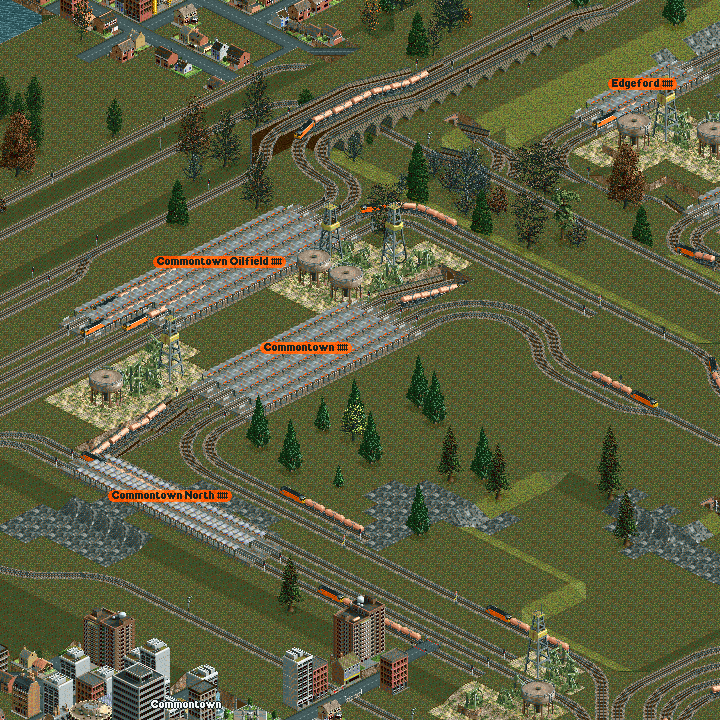 As a slave to production, my works end up looking almost as messy as the AI. These are my two primary wells. I even ended up with derelict locomotives on sidings during low-production depressions, as it's more effective to have them sitting out of the way than clogging up the works, and when times get better, you just start them up again! Jaguars! fucked around with this message at 11:00 on May 24, 2016 |
|
|













